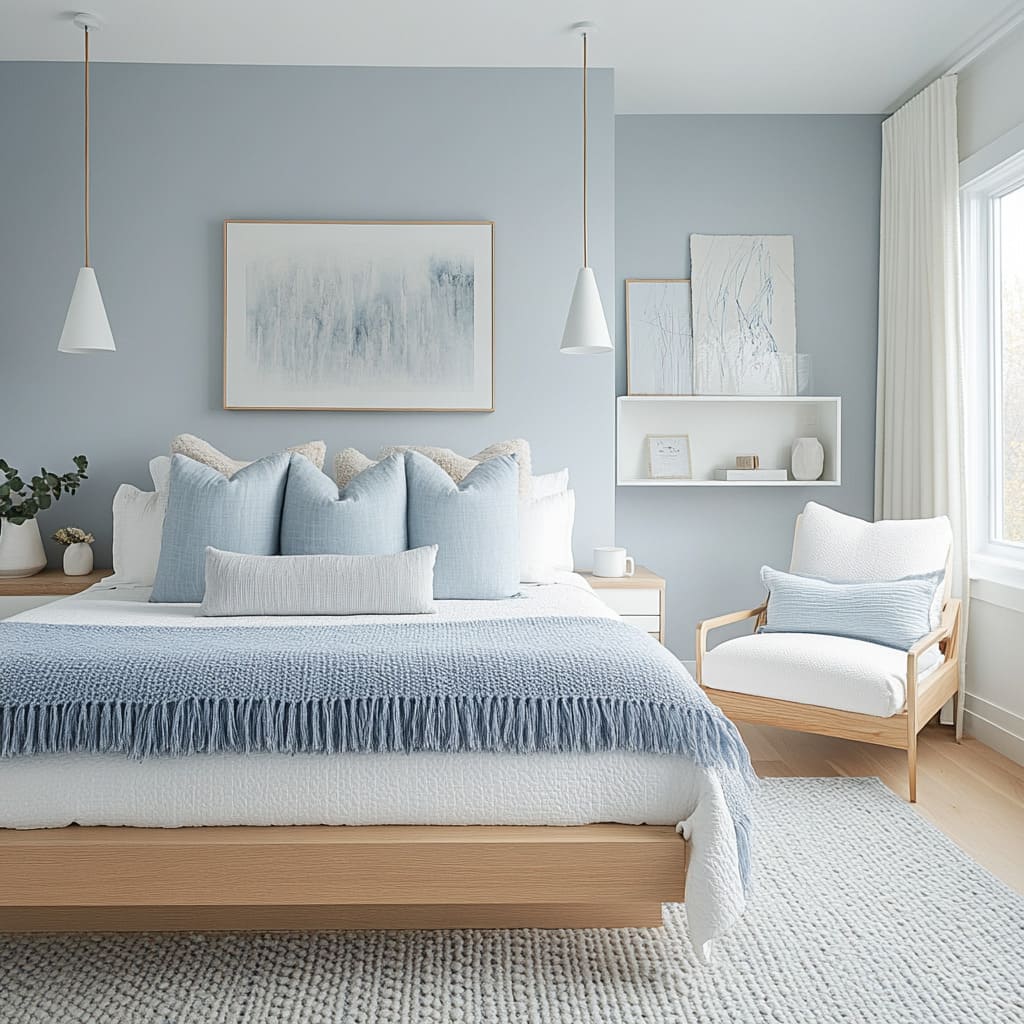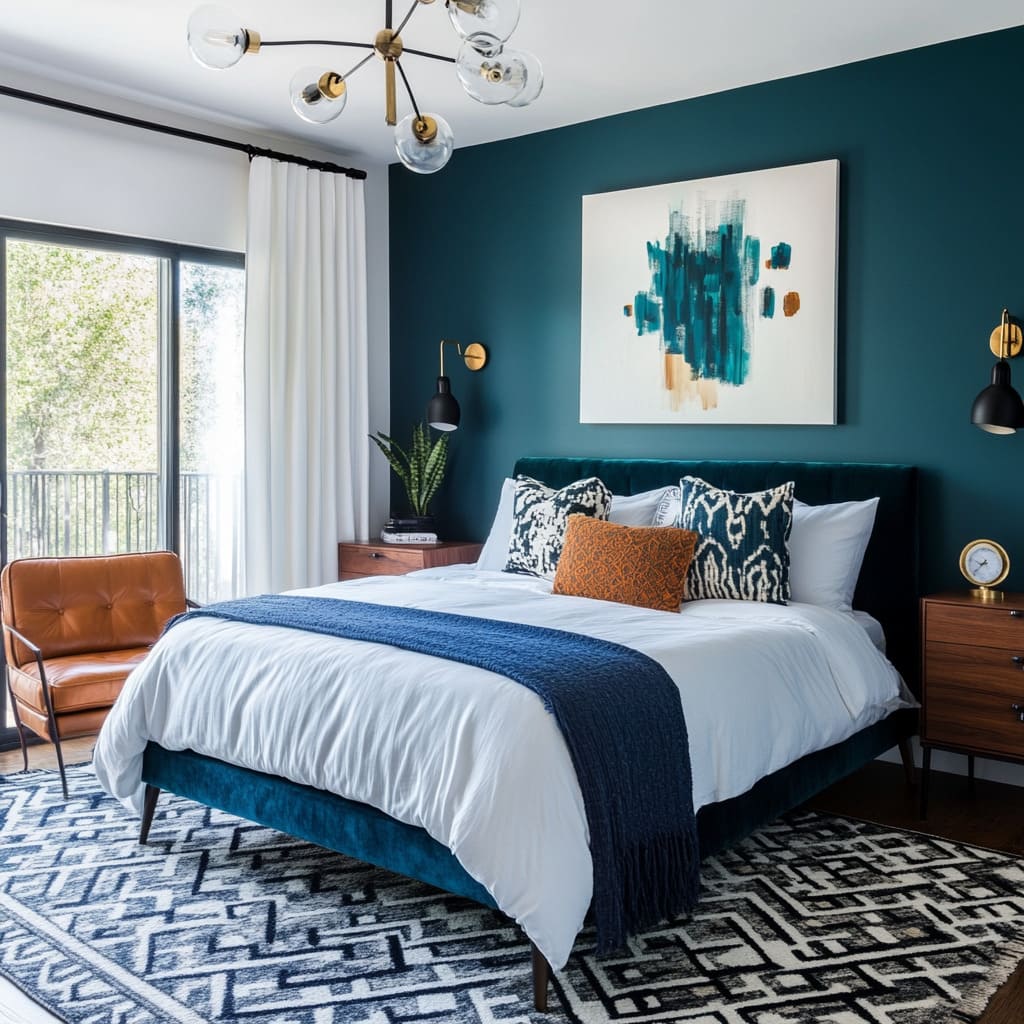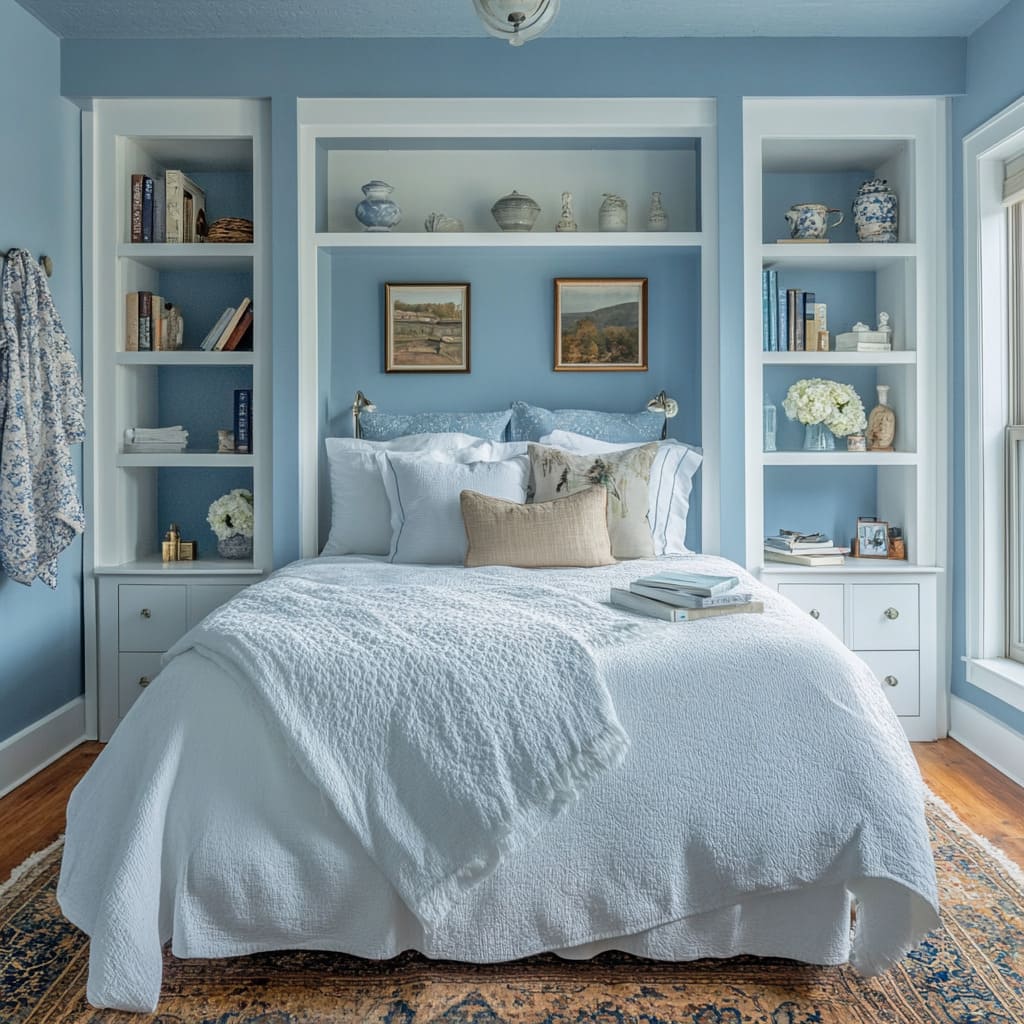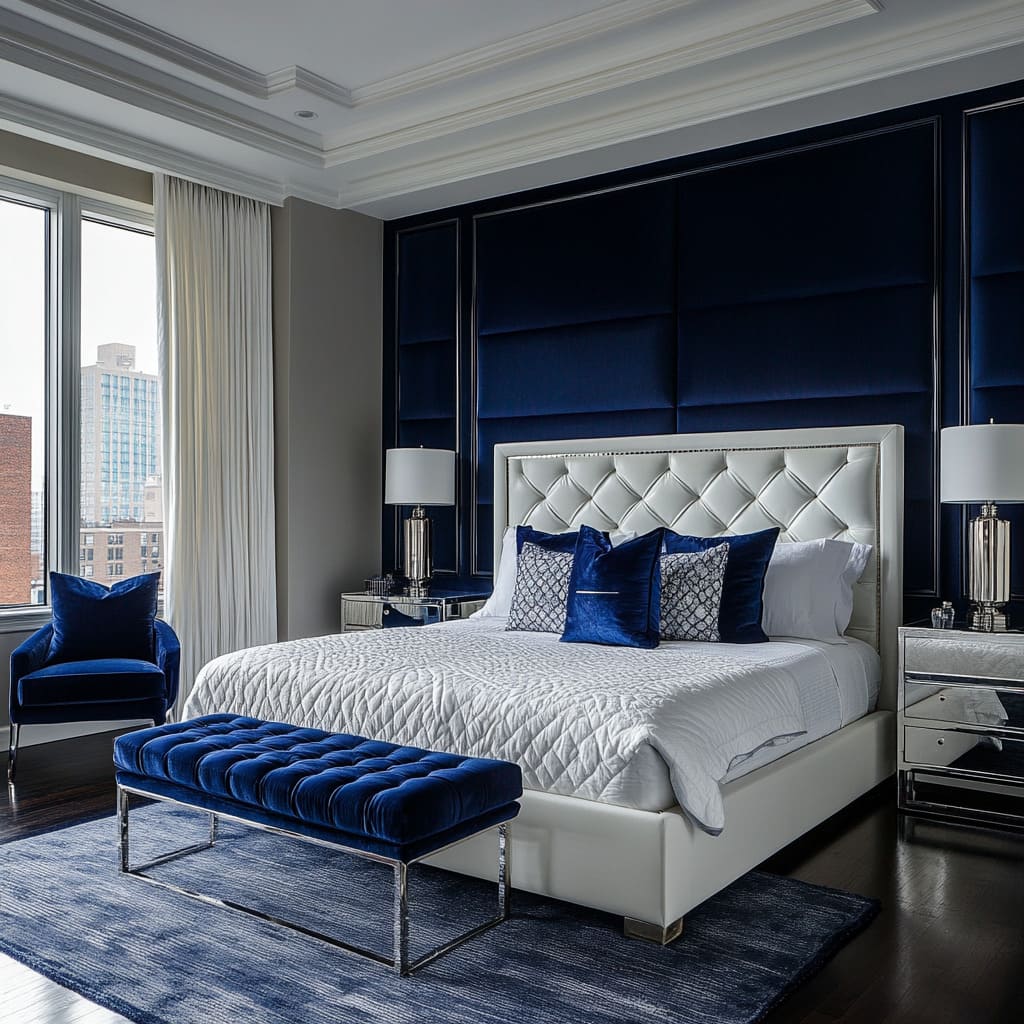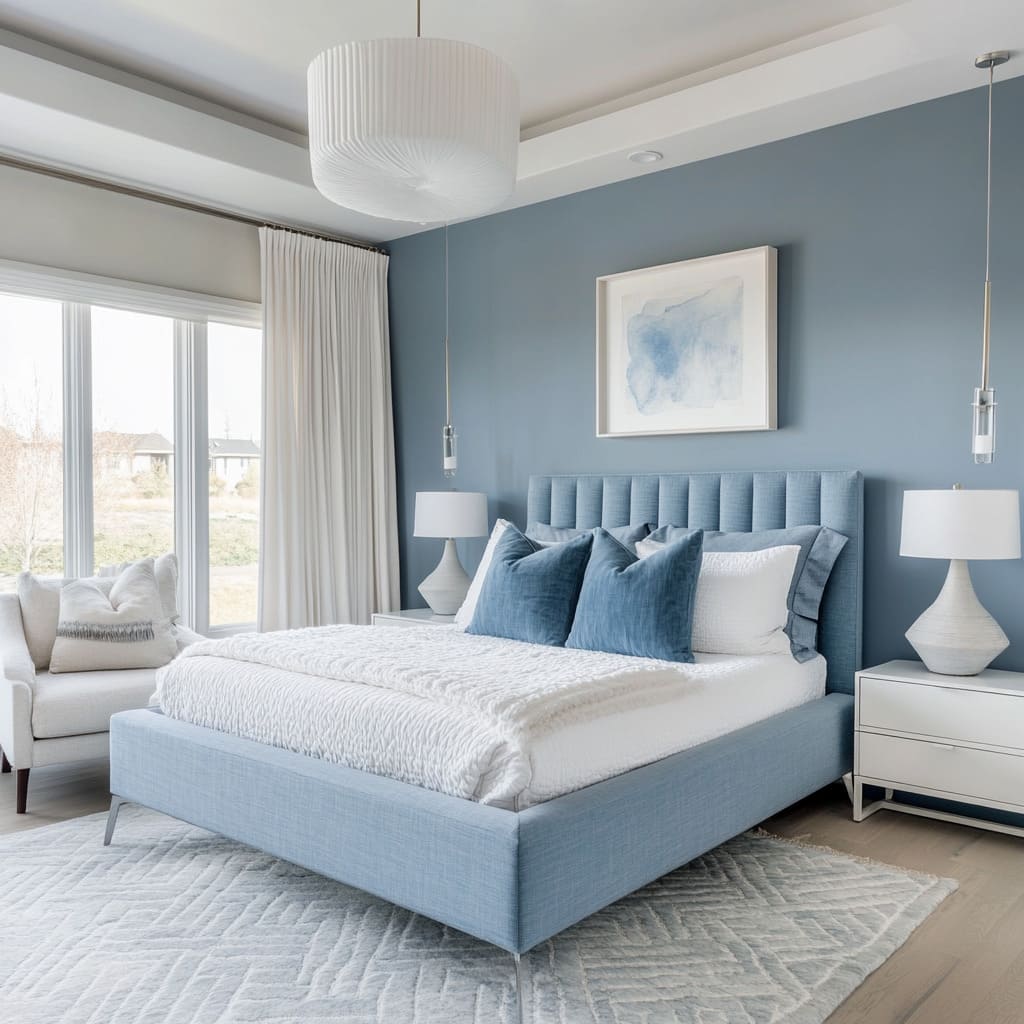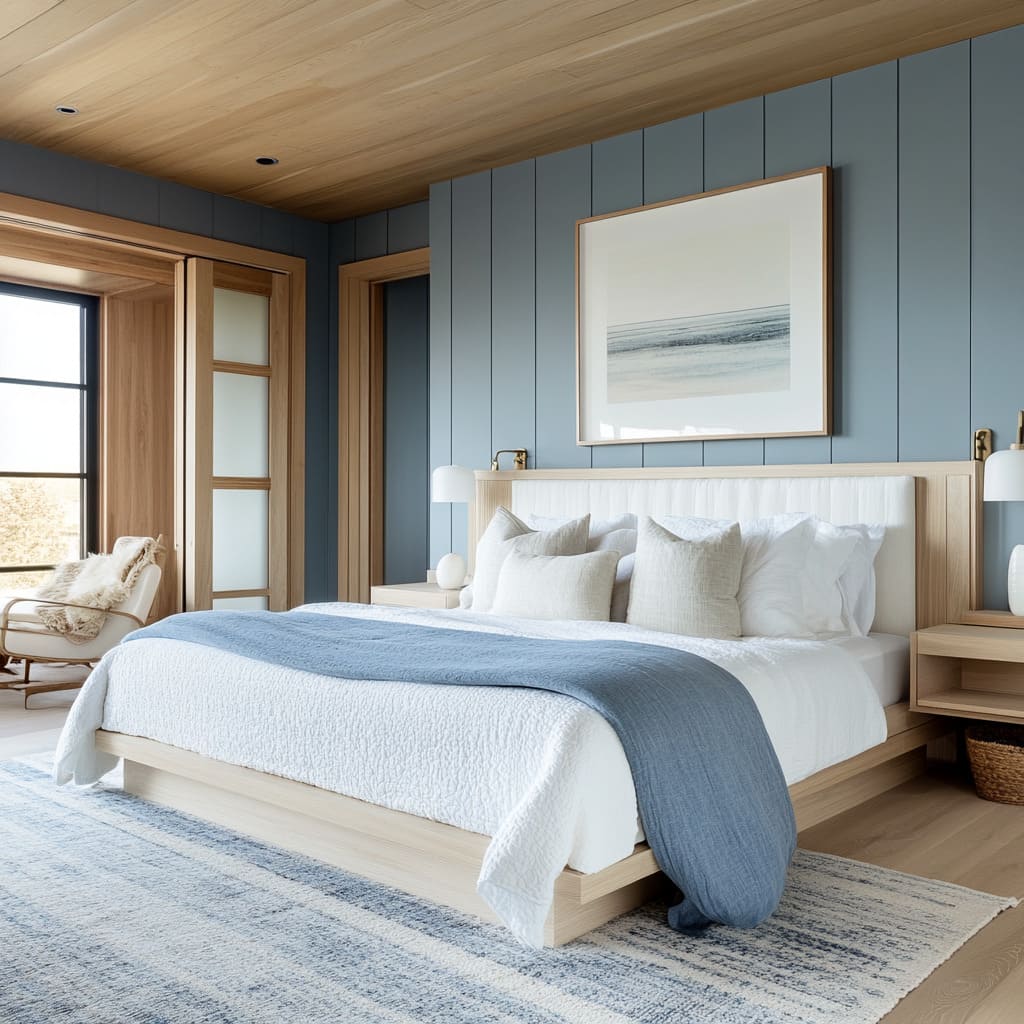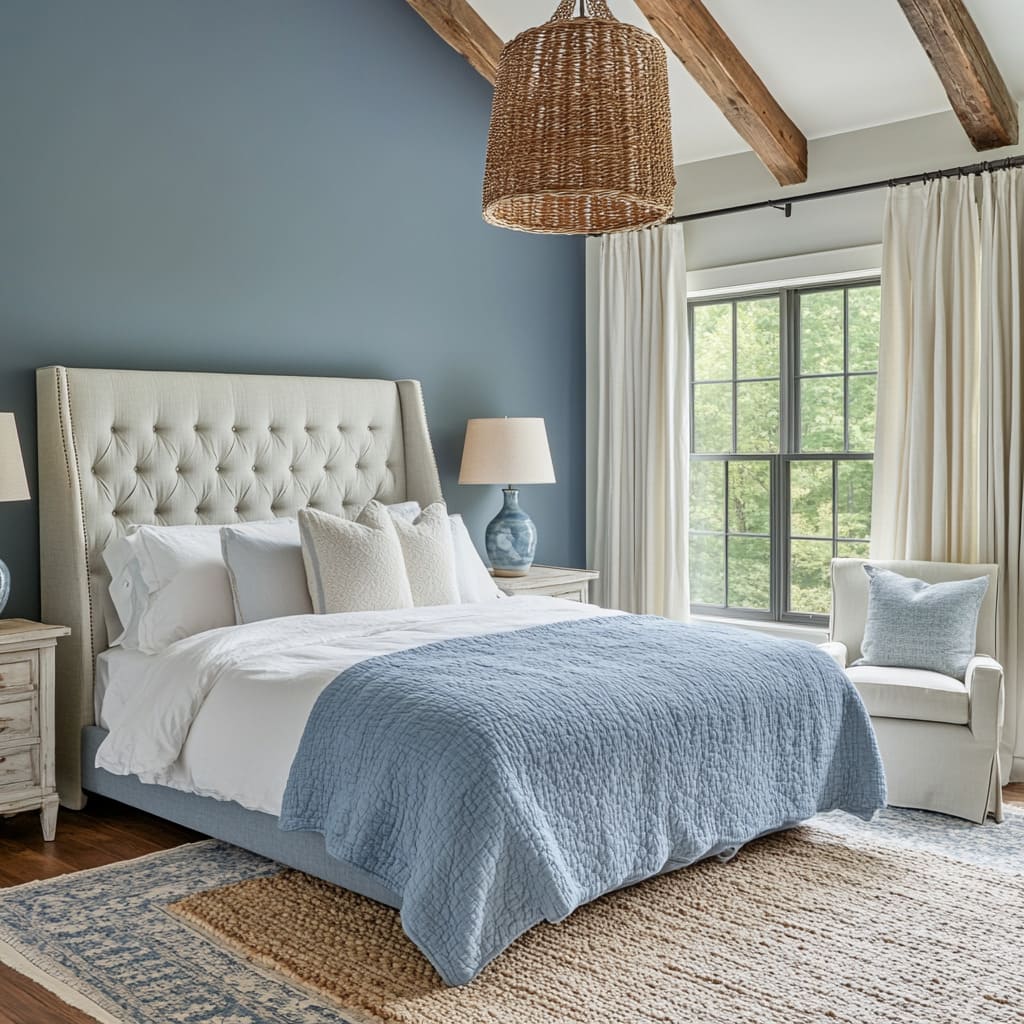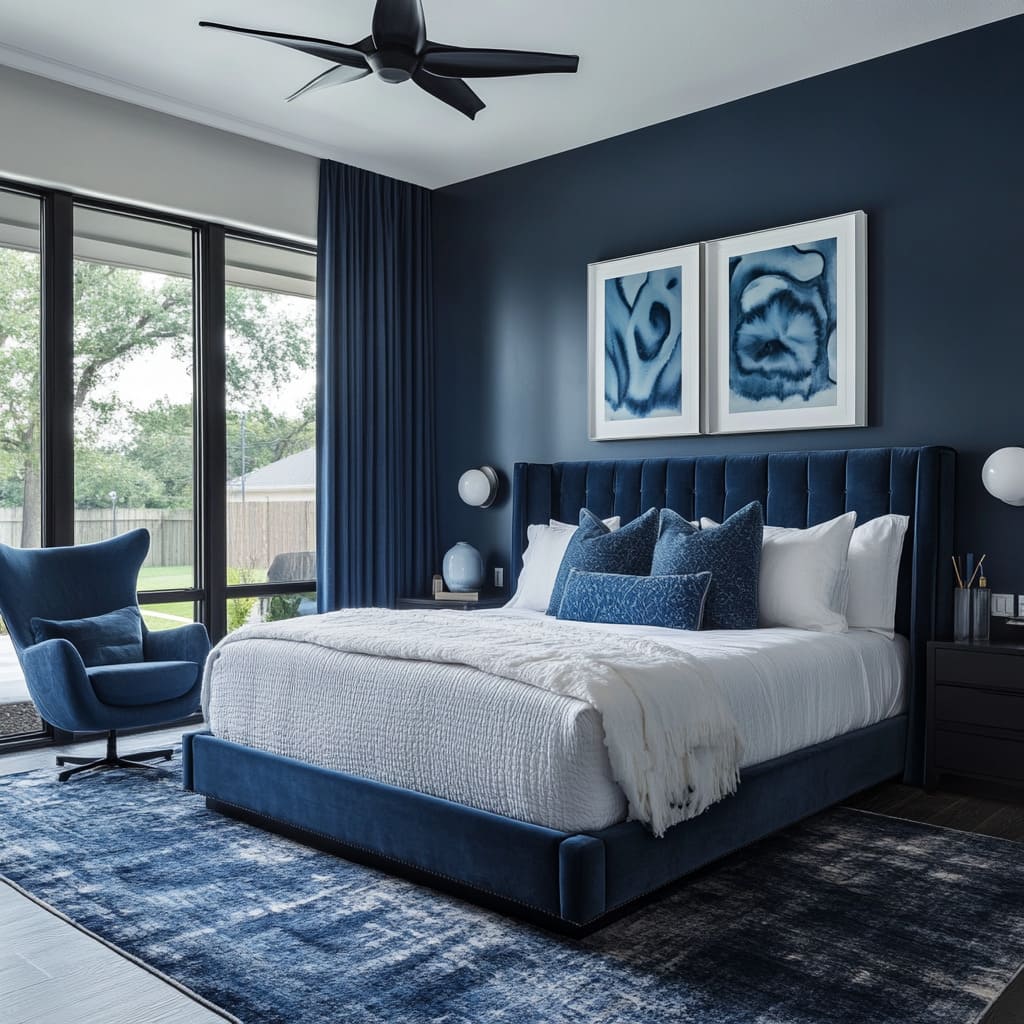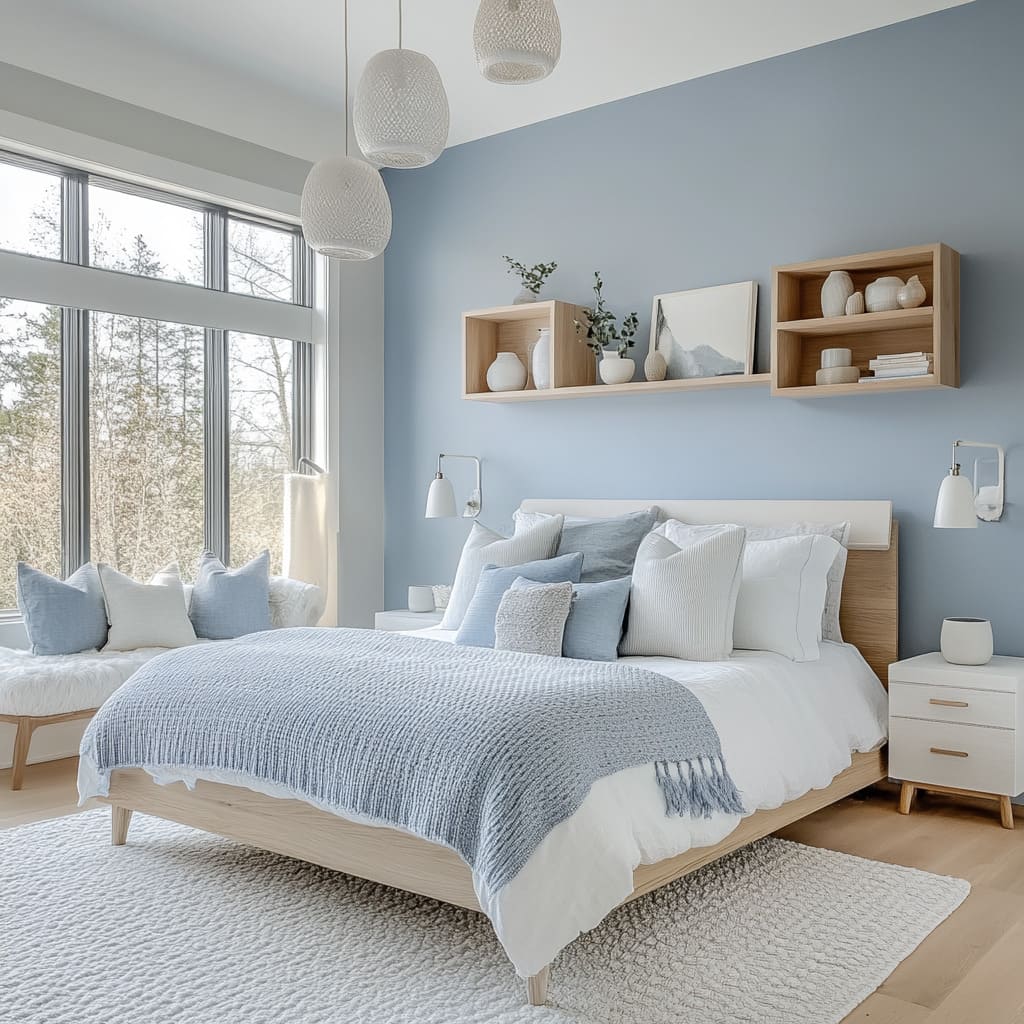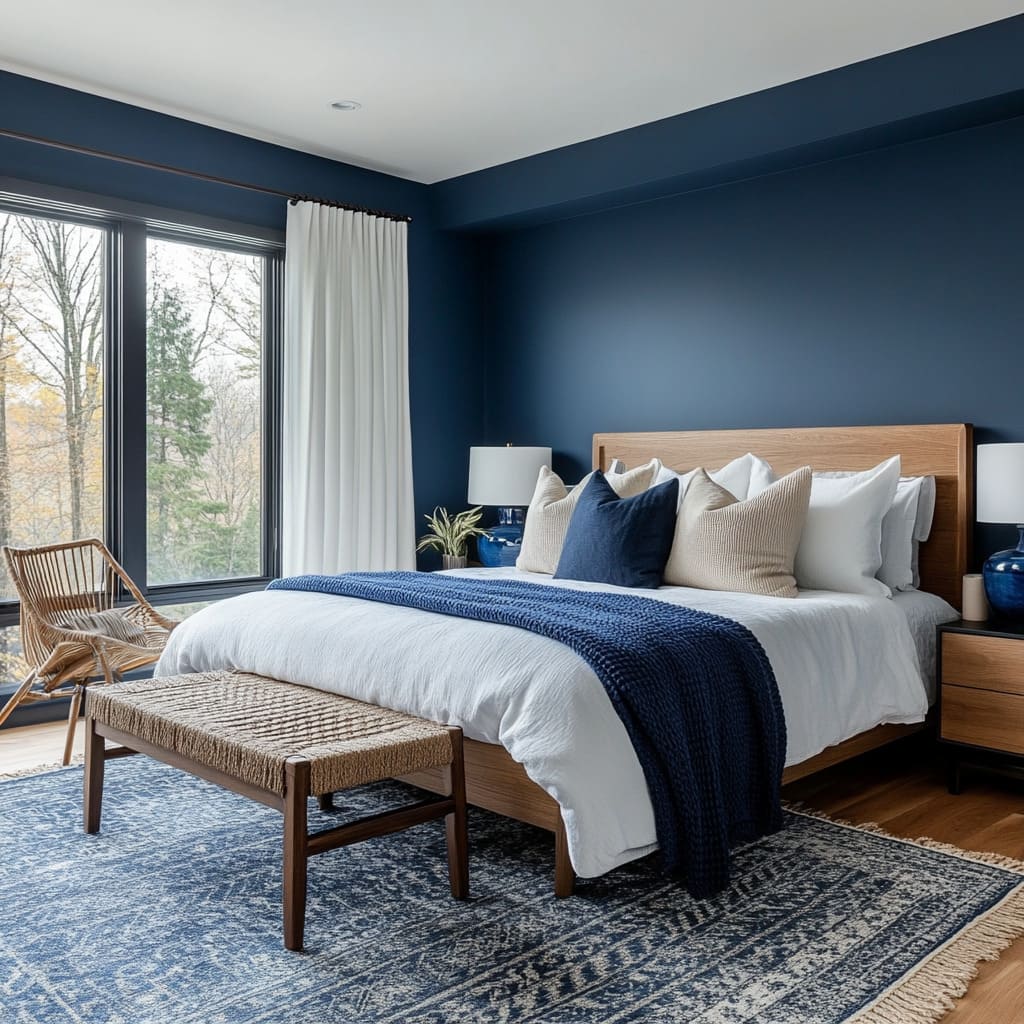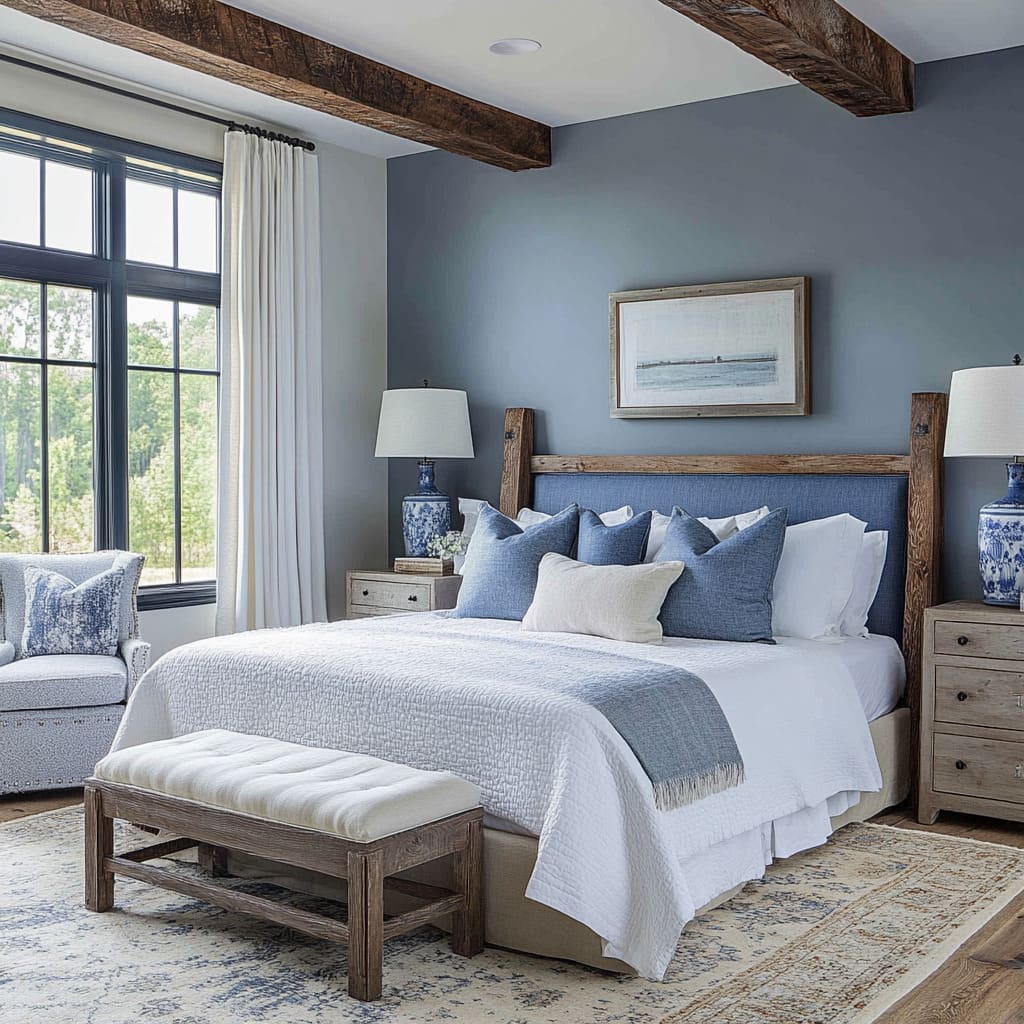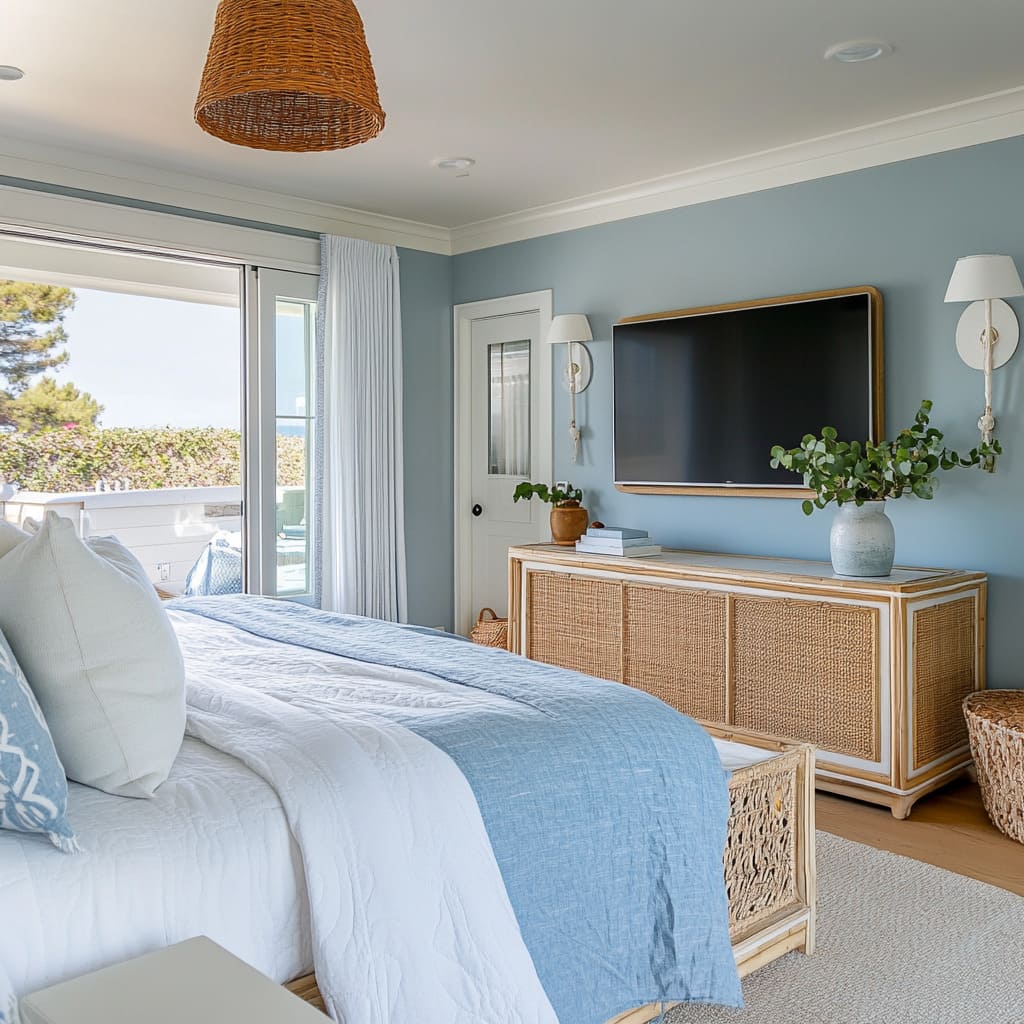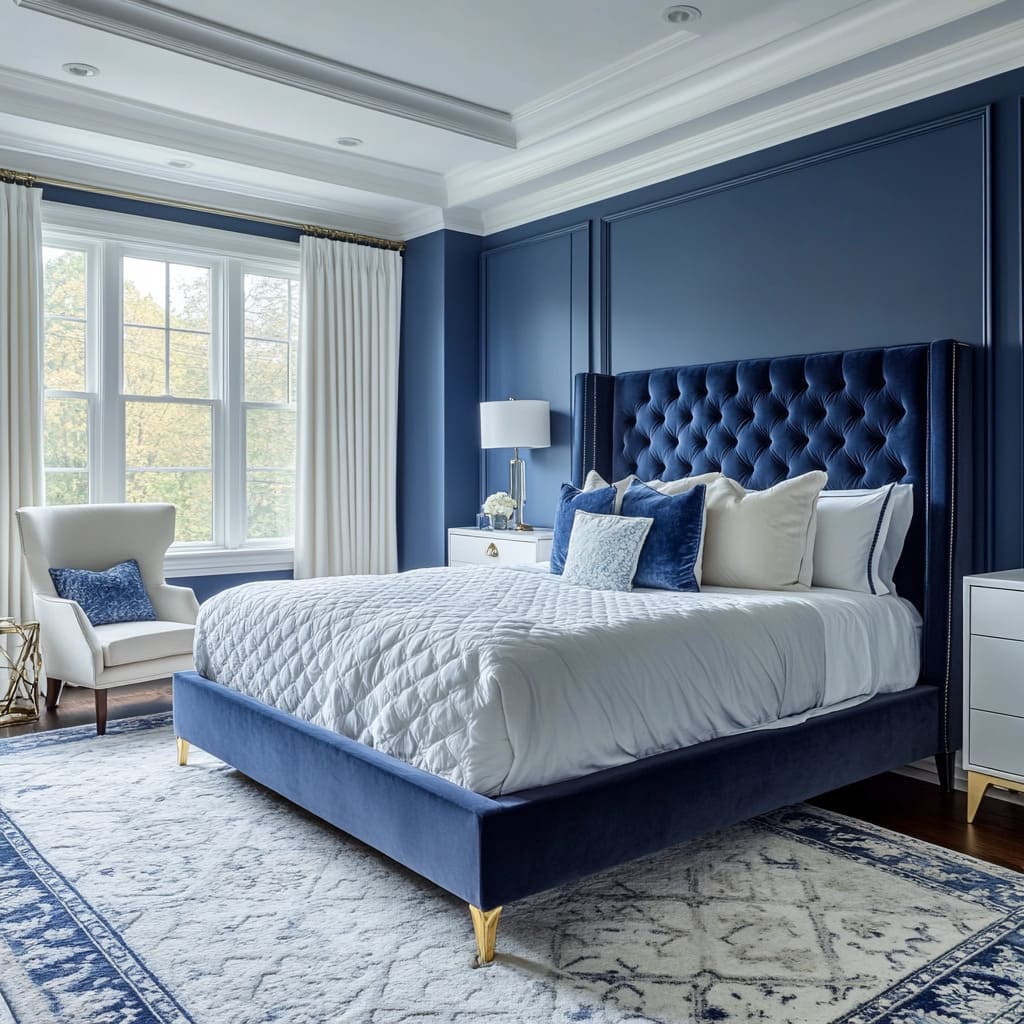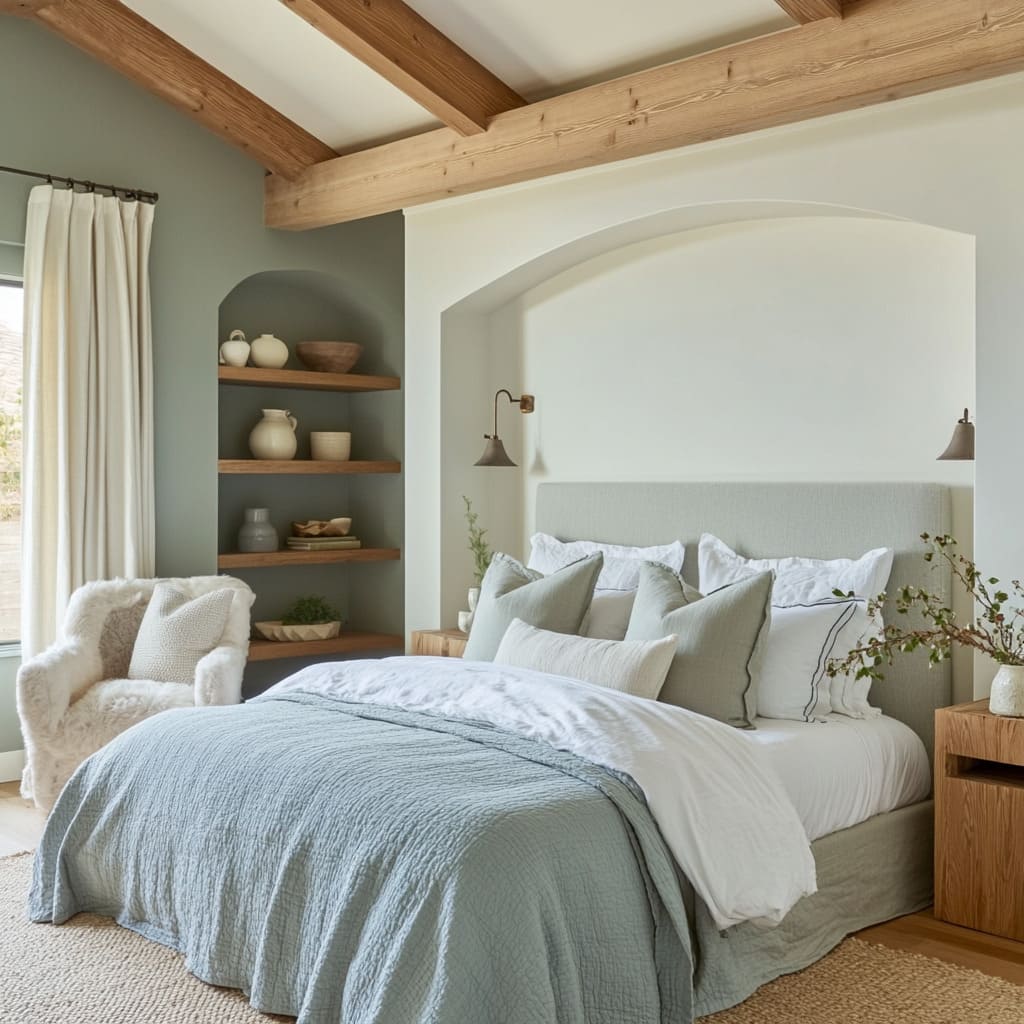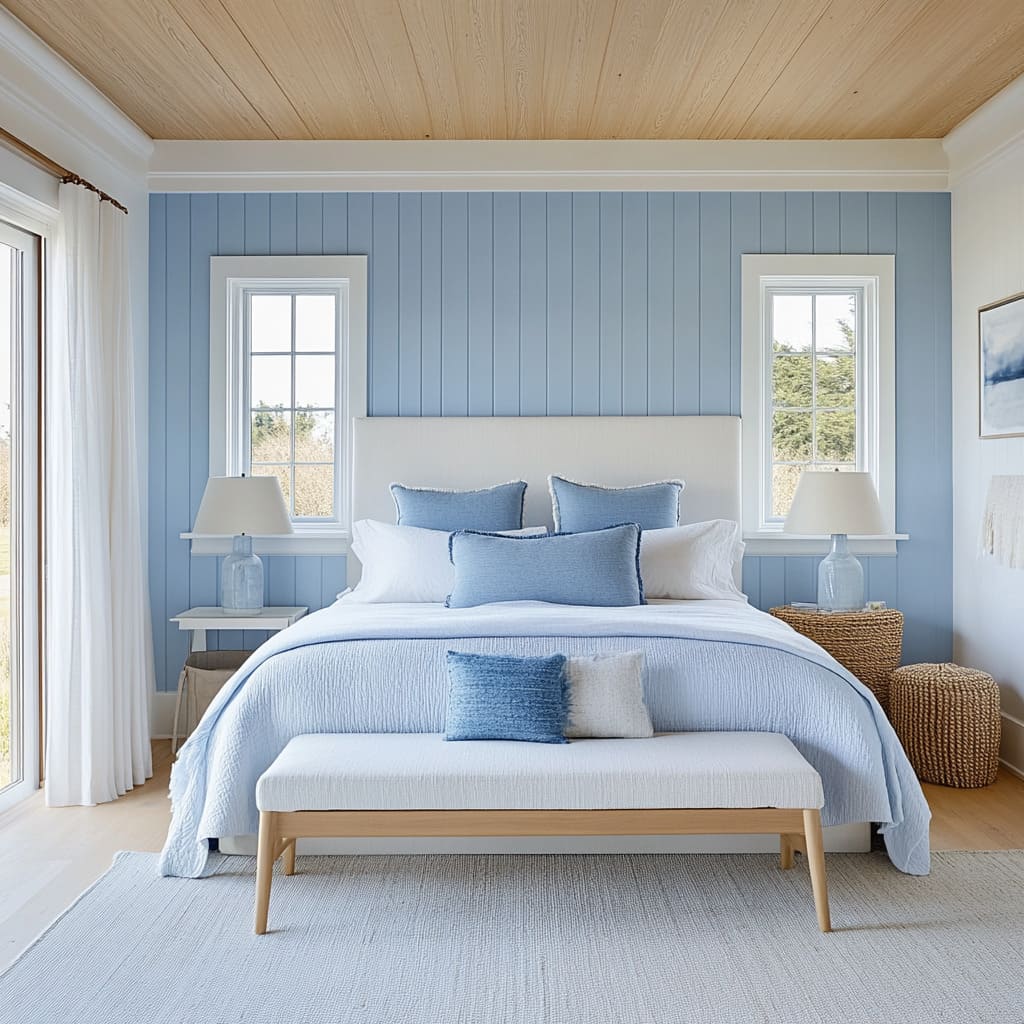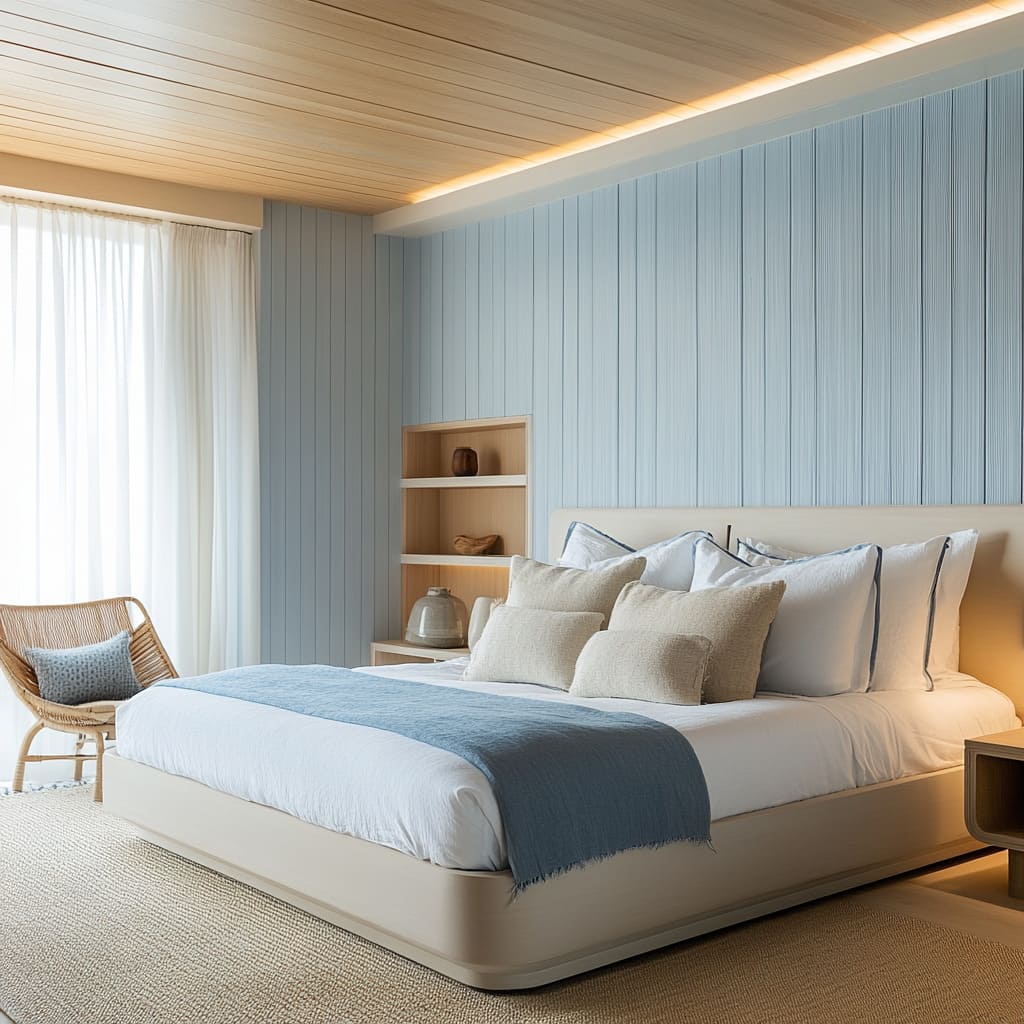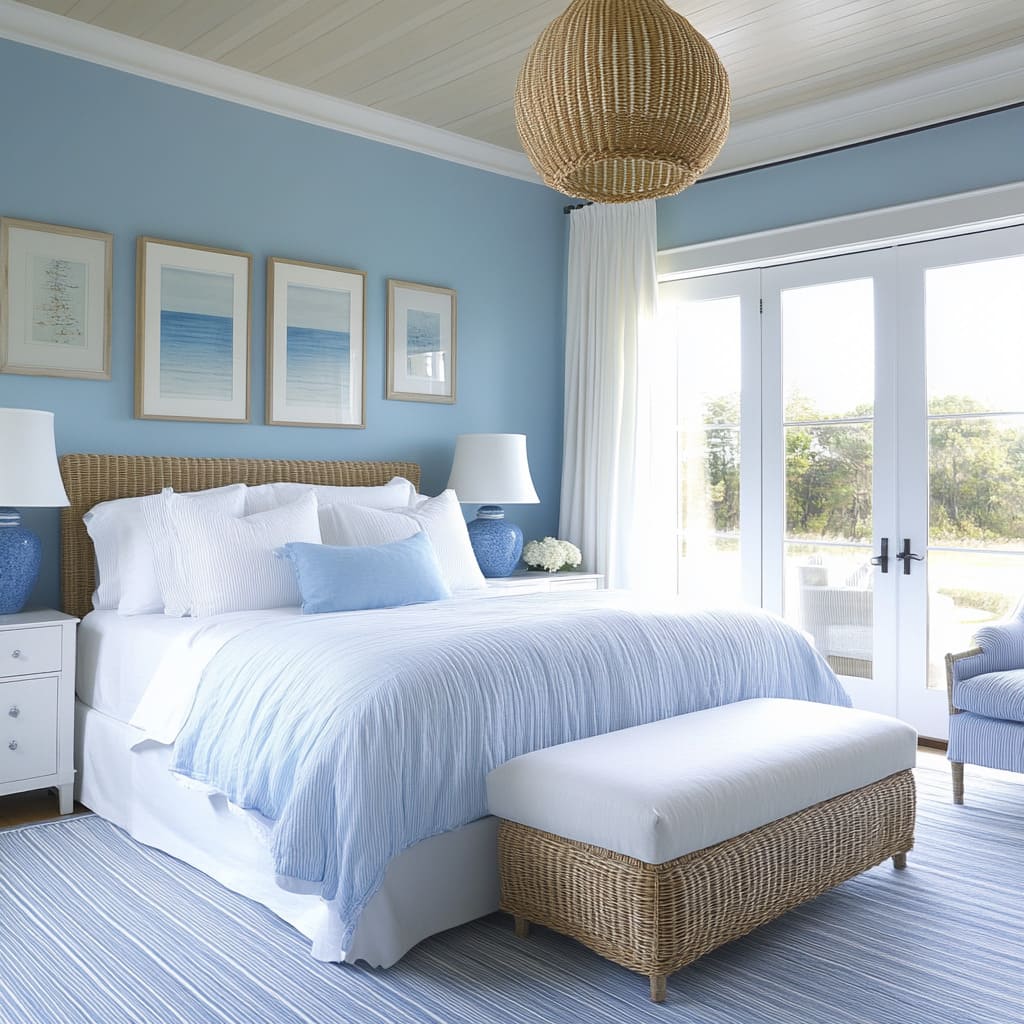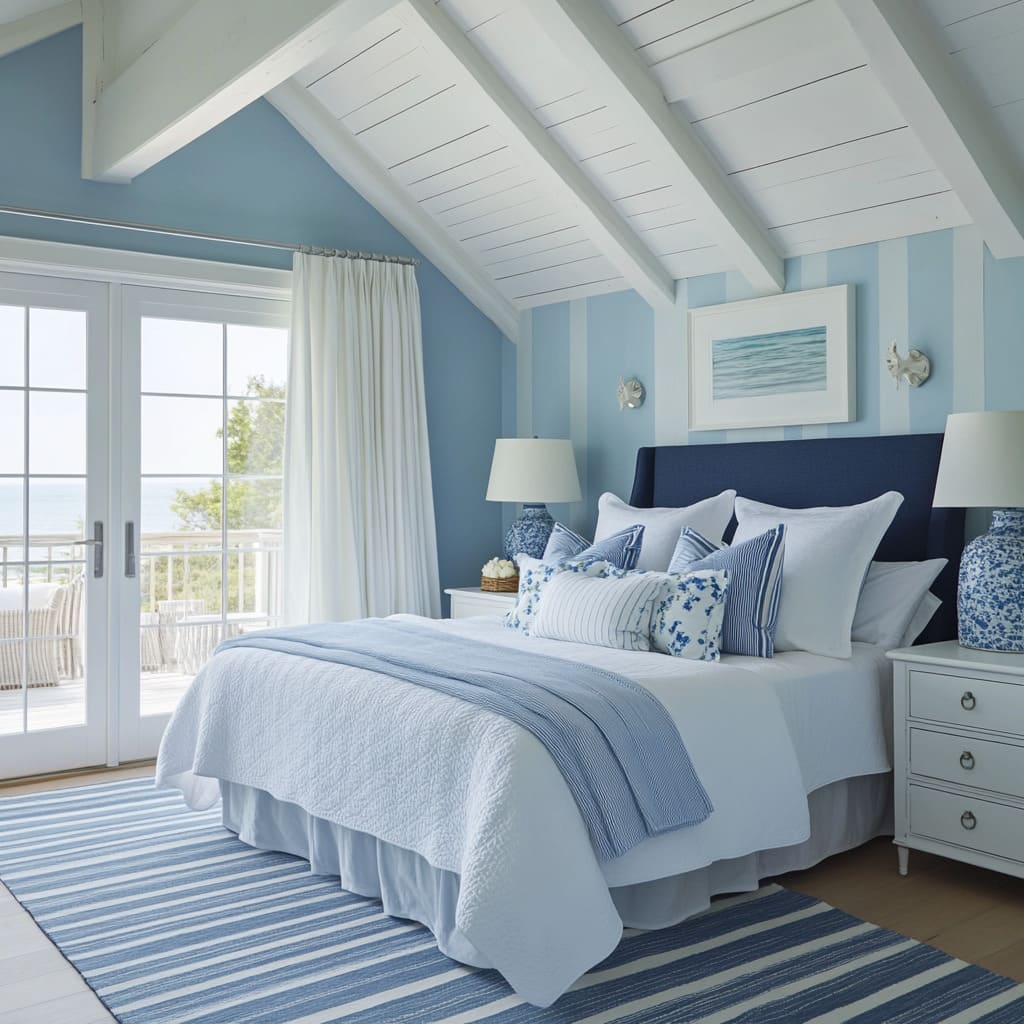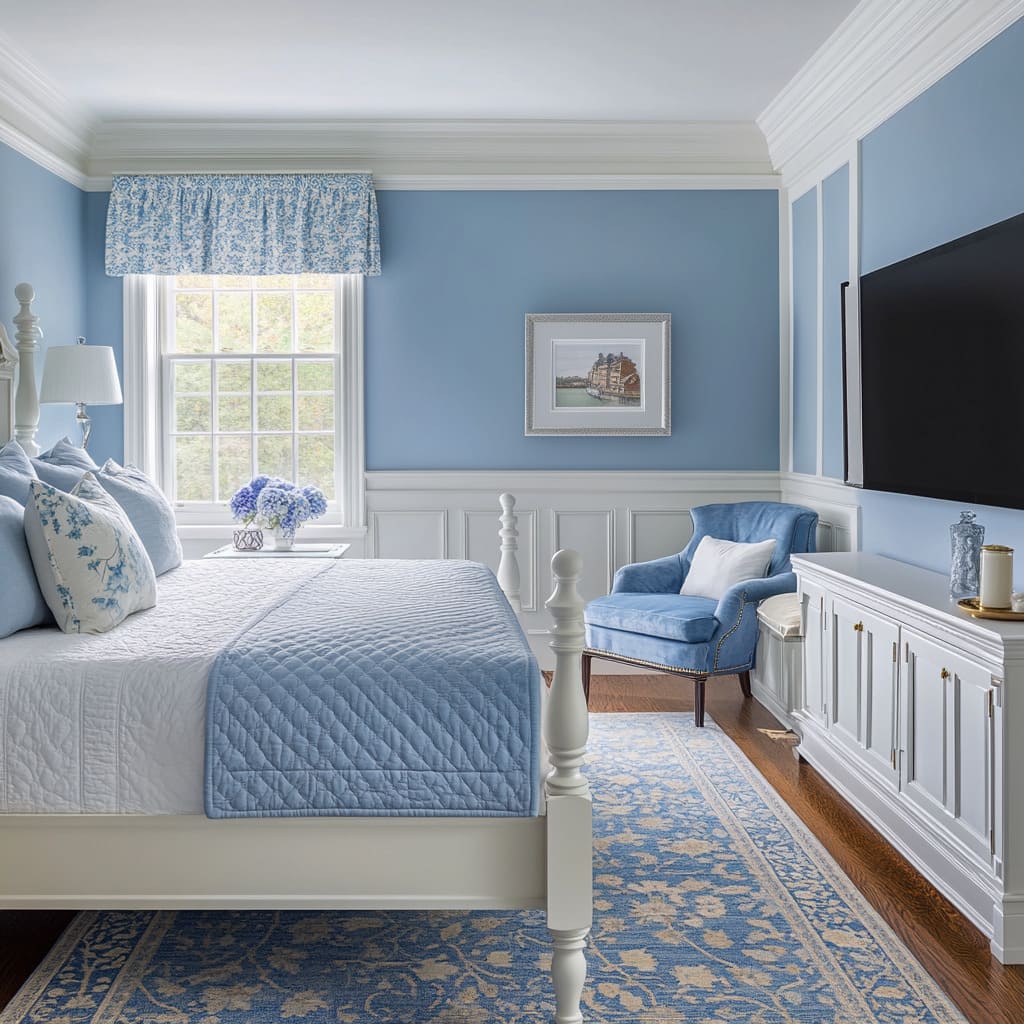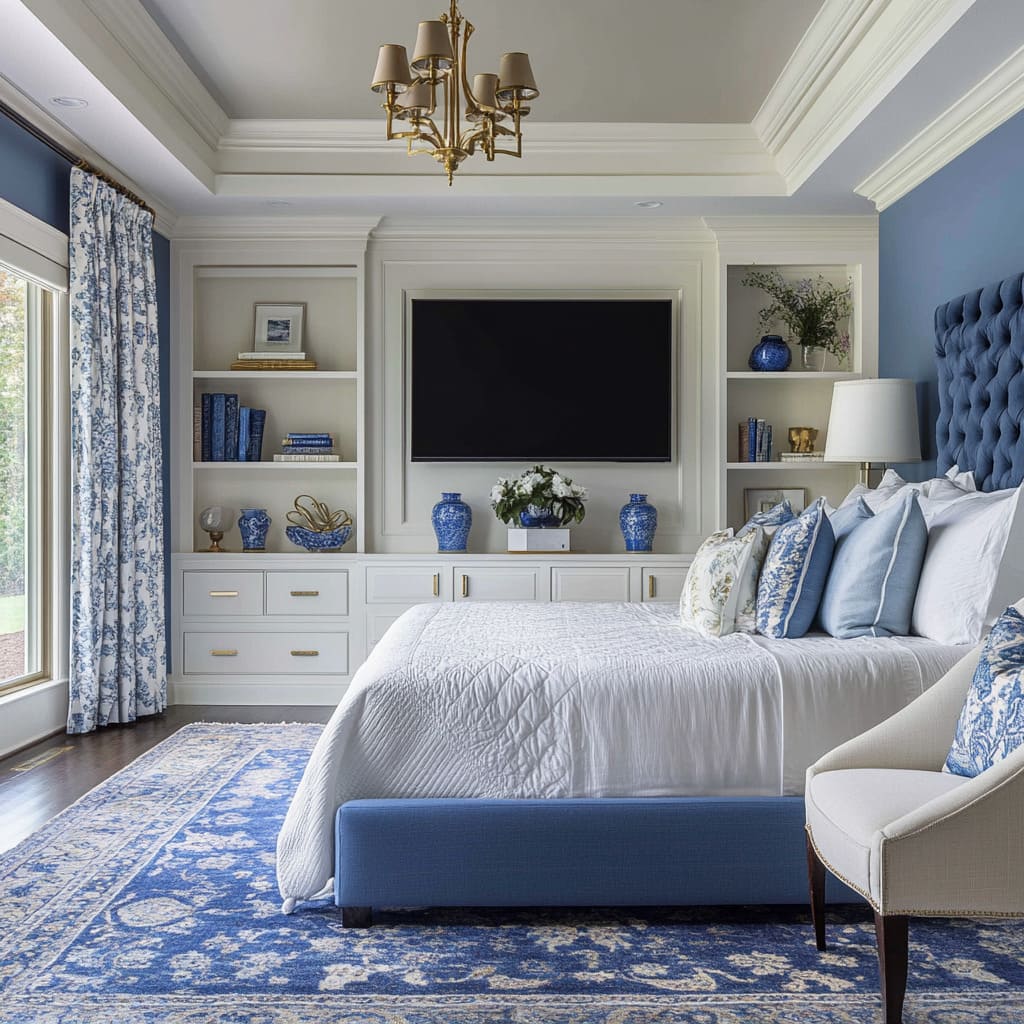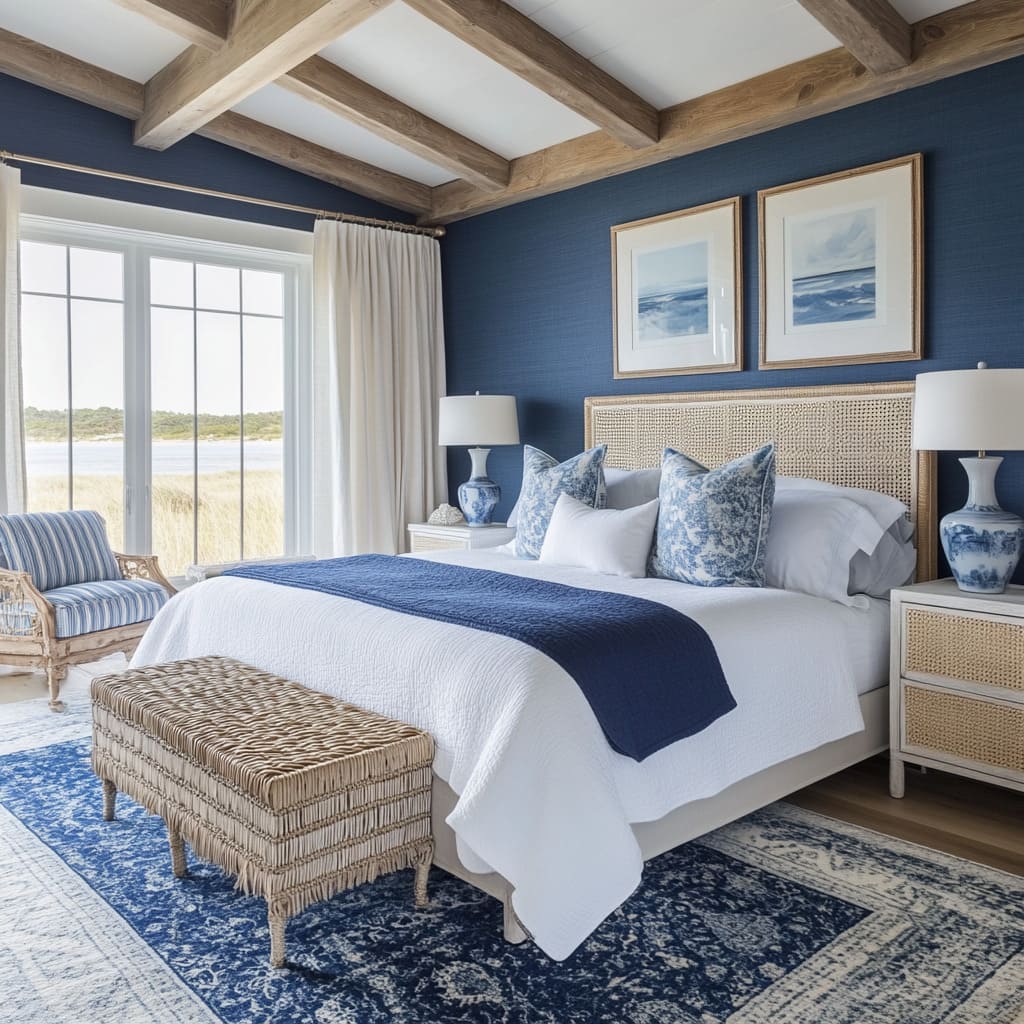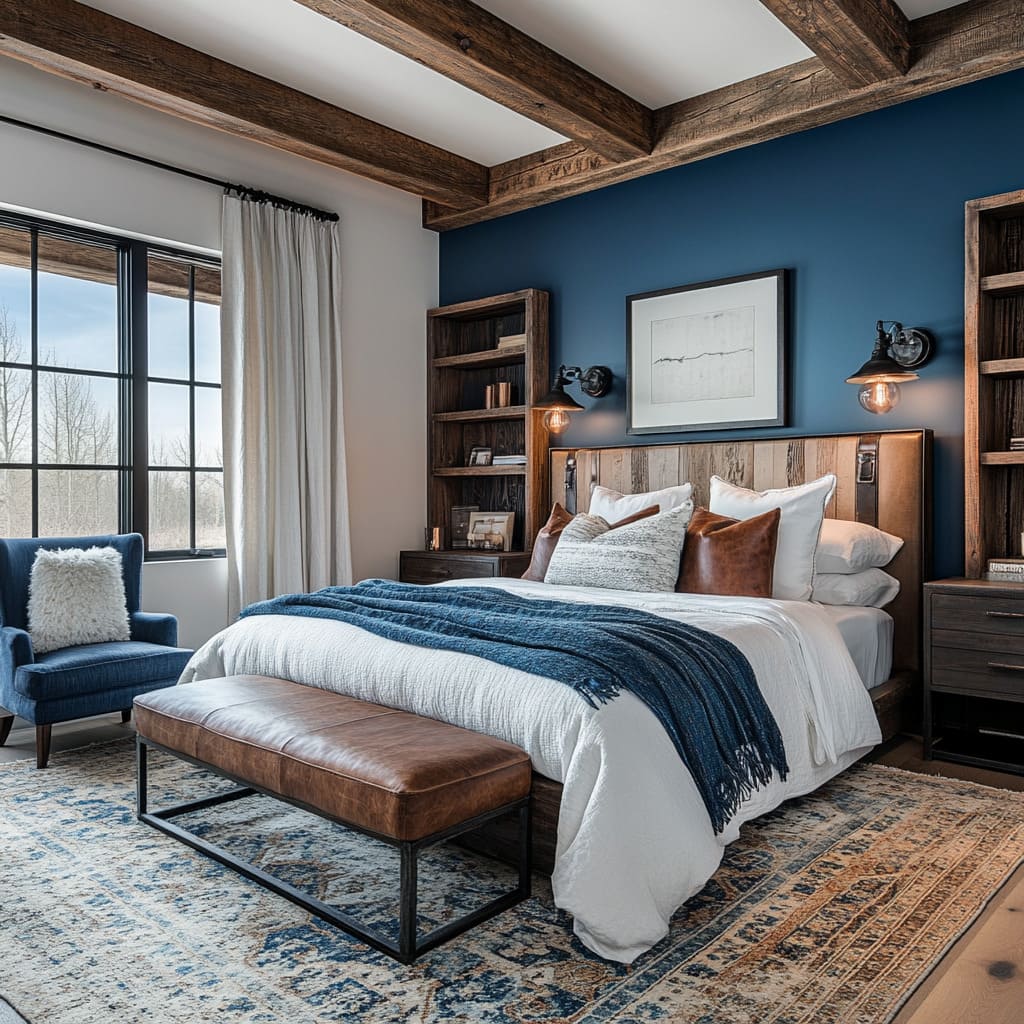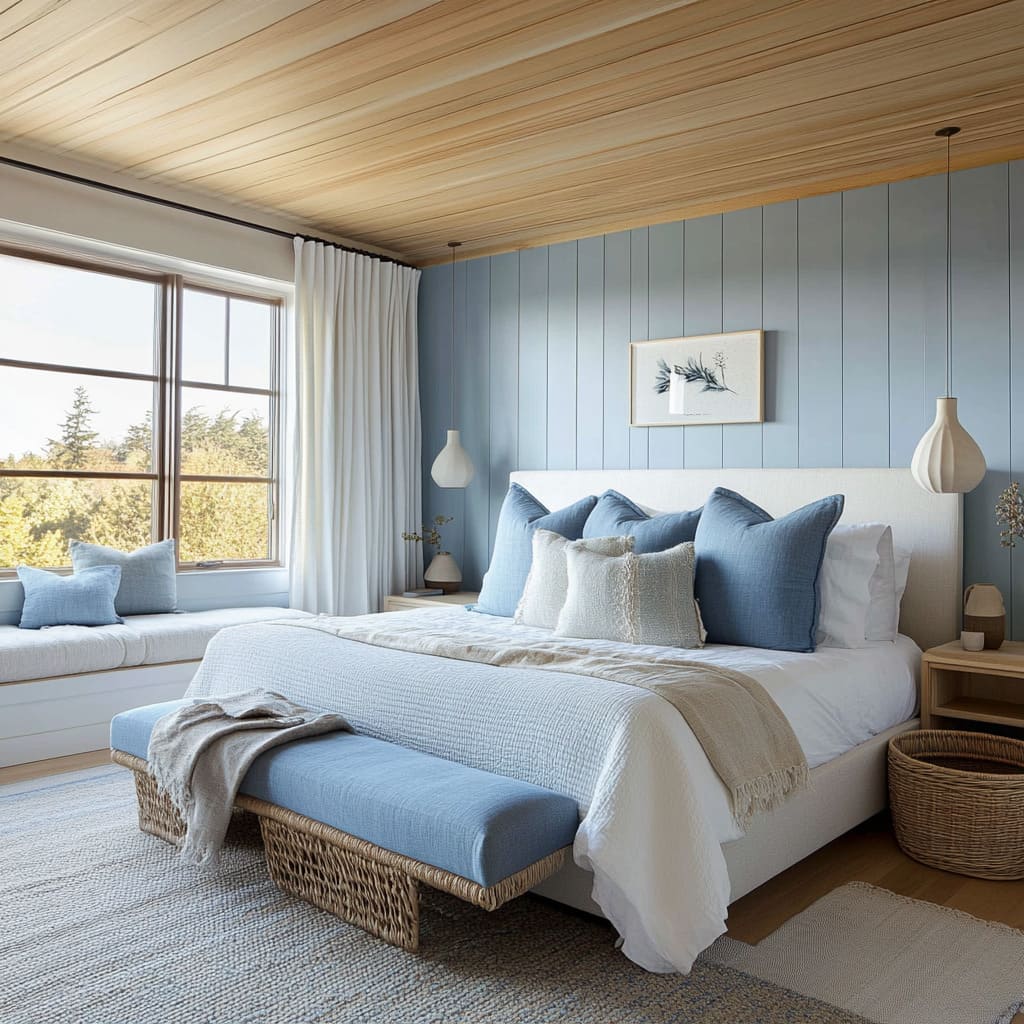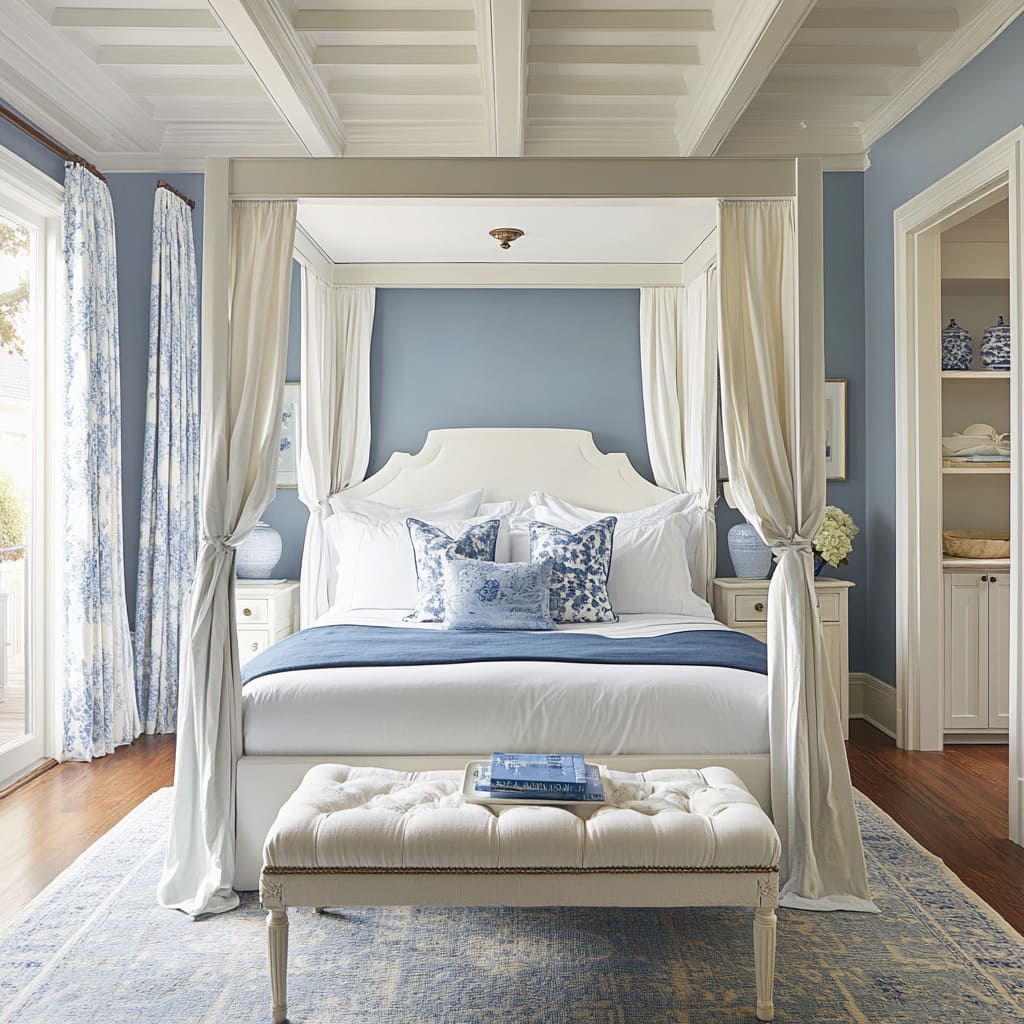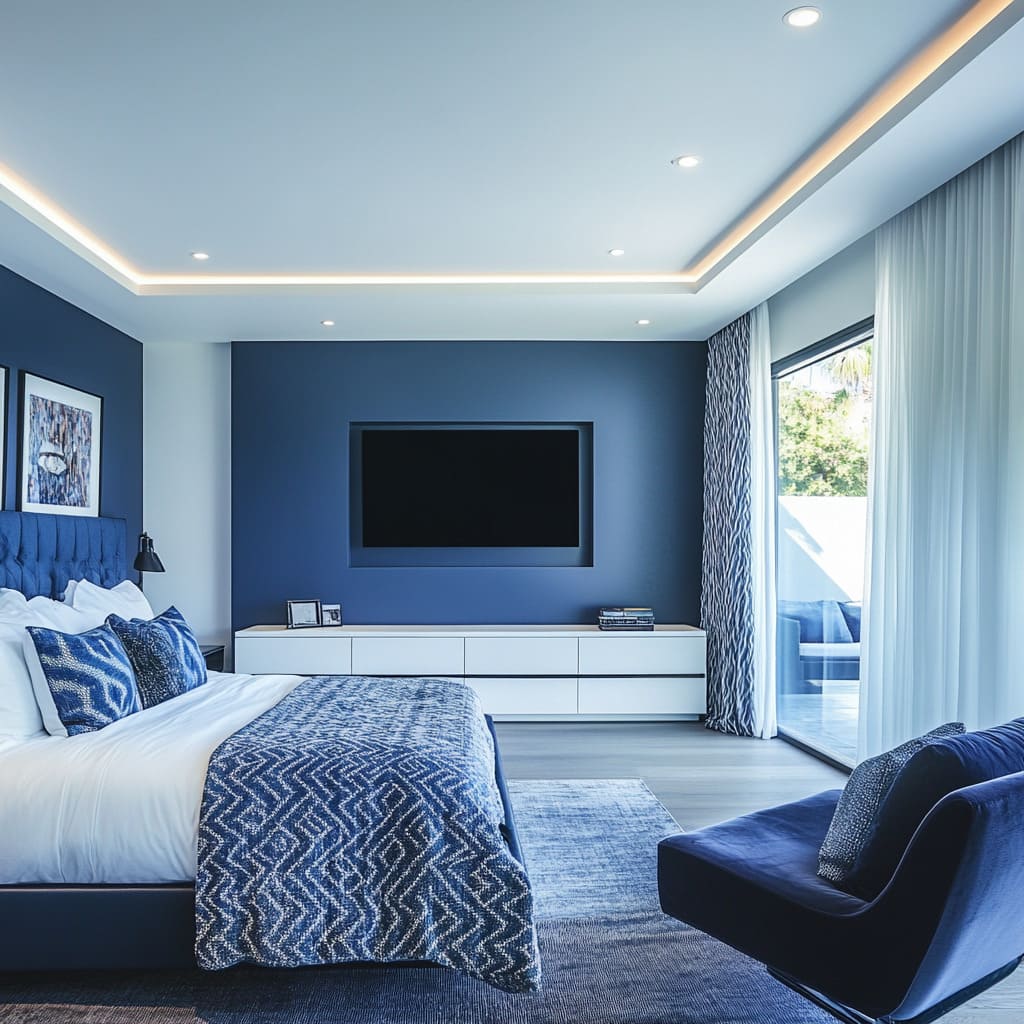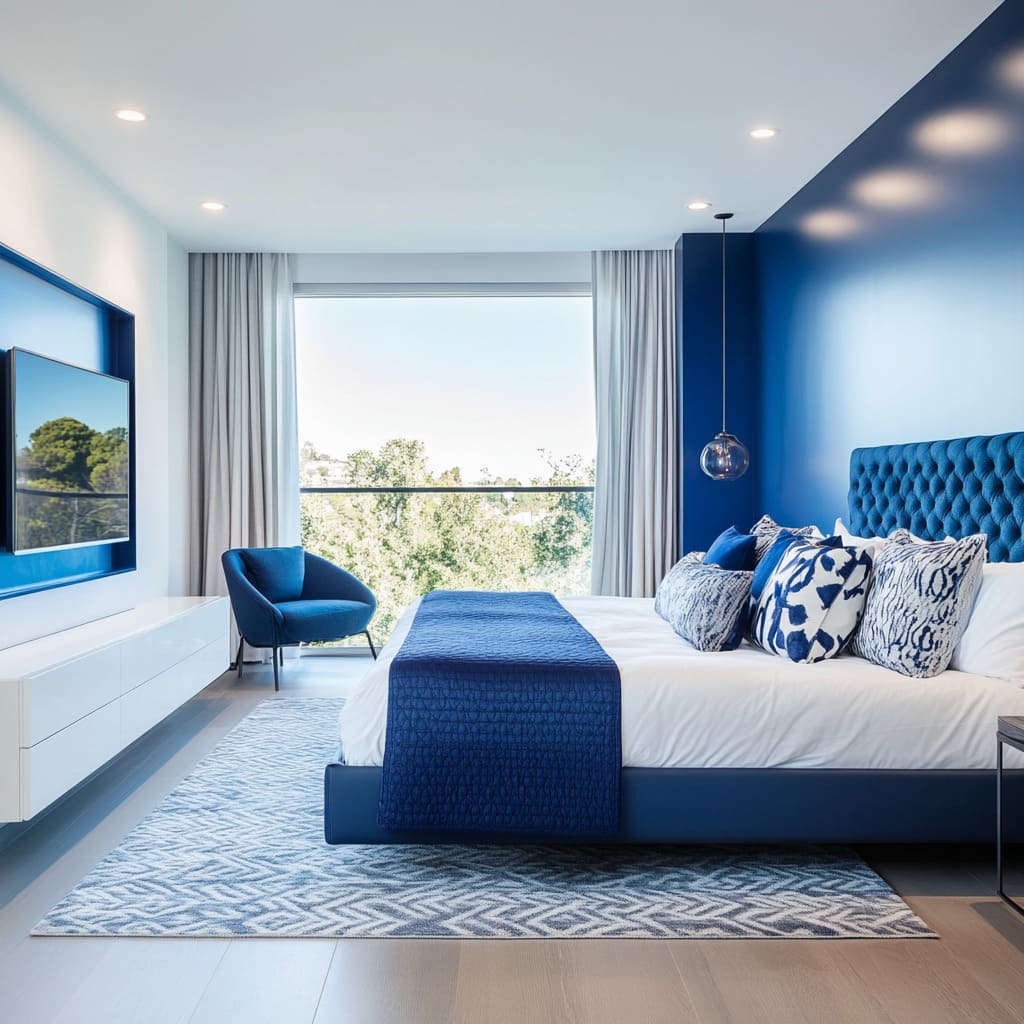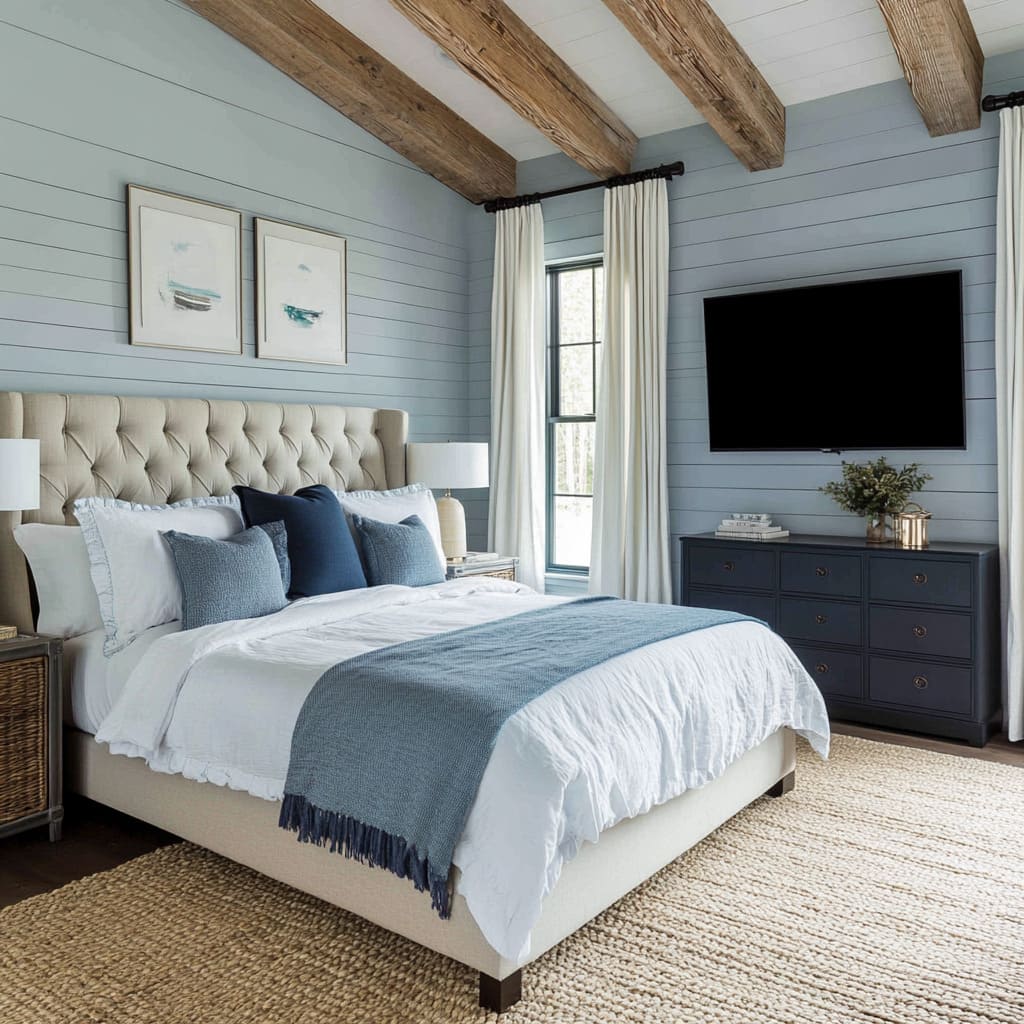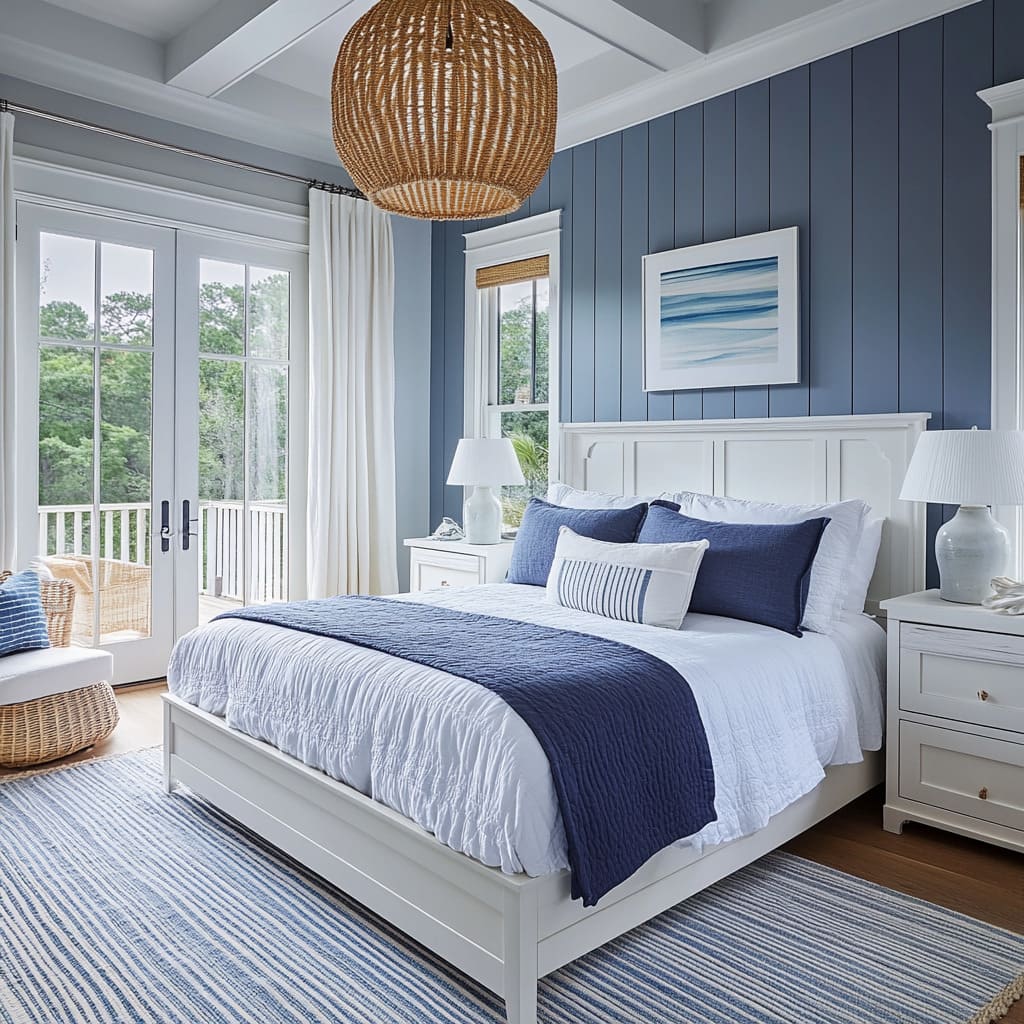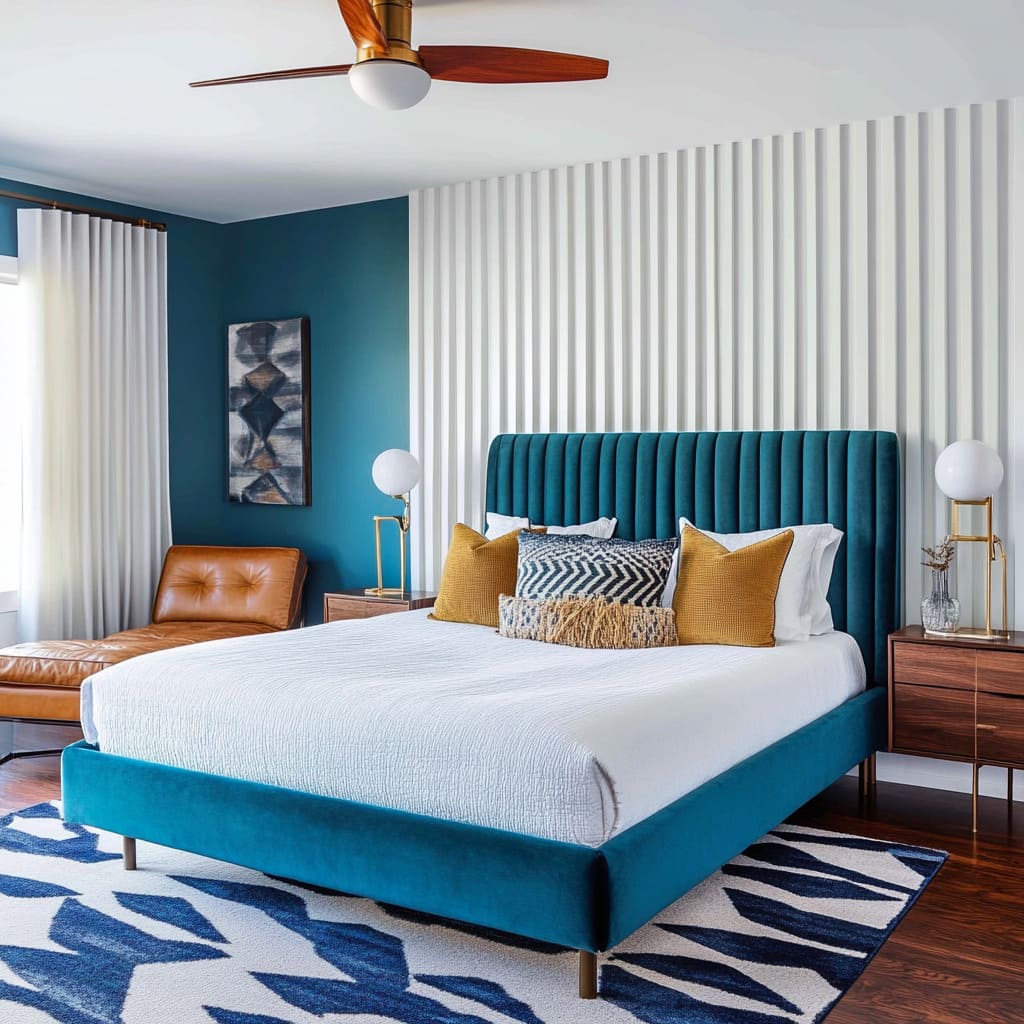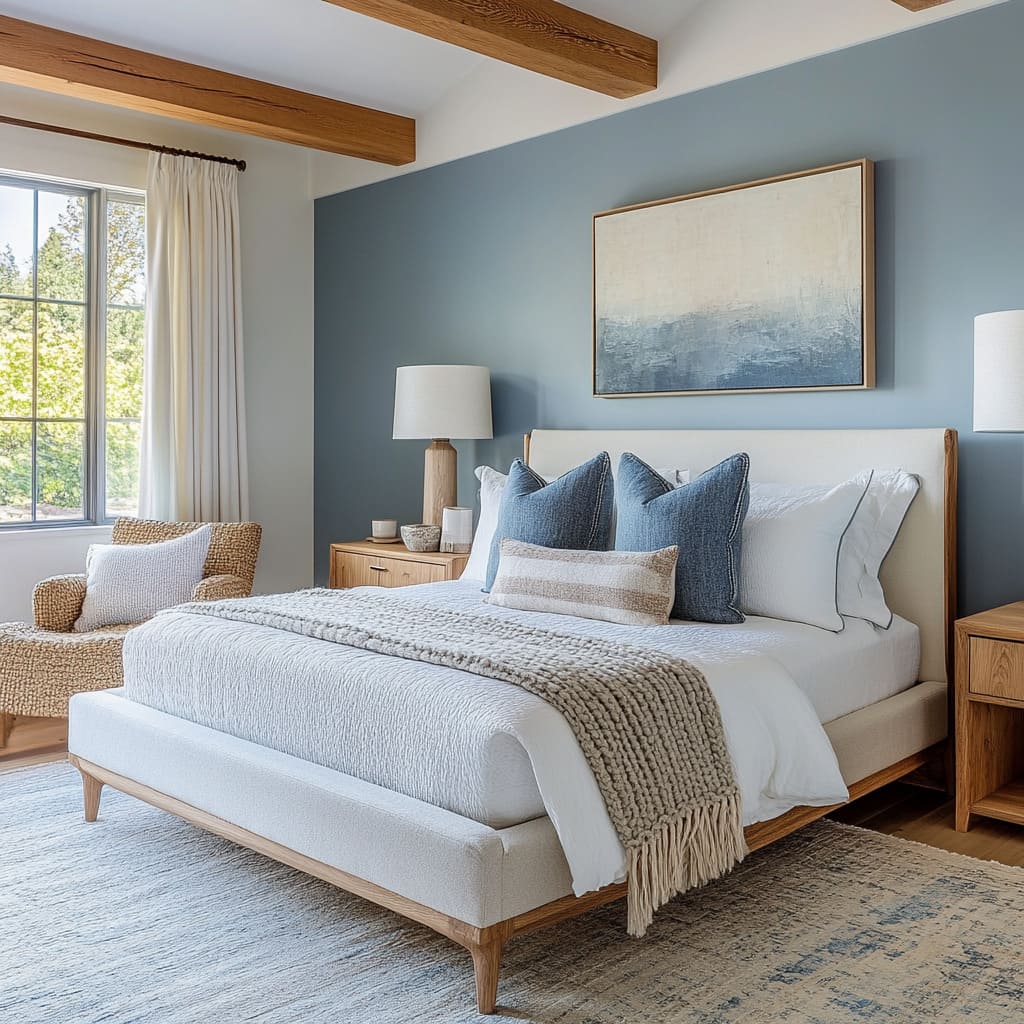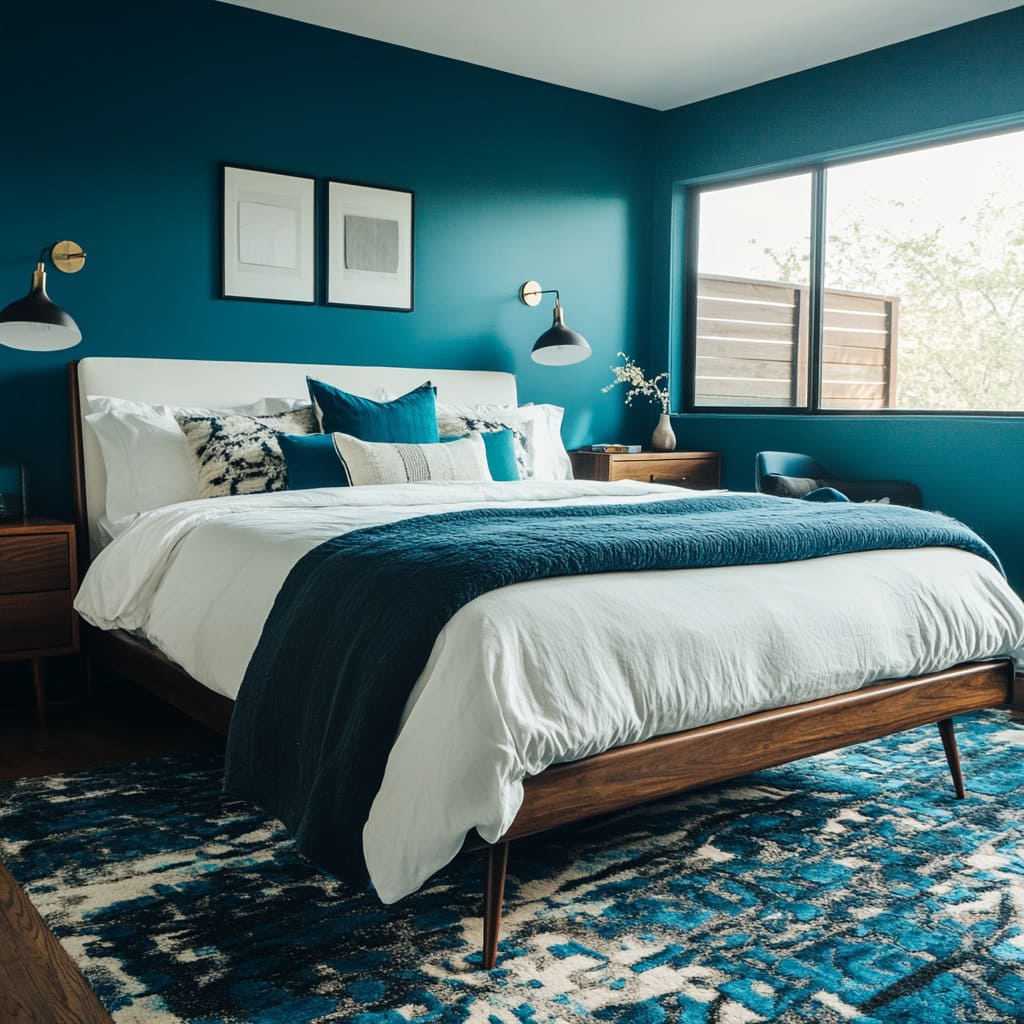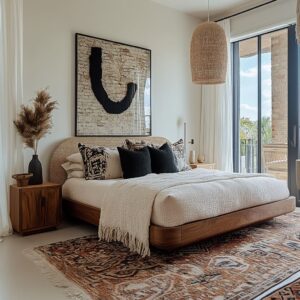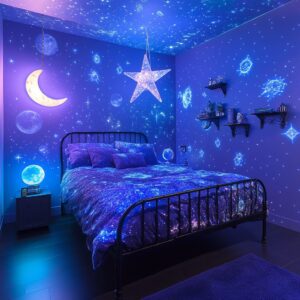Few color combinations feel as versatile and inviting as blue and white. Whether you’re drawn to soft pastels for an airy feel or deep navy tones for a dramatic touch, this classic pairing never goes out of style.
From breezy coastal-inspired retreats to bold, modern spaces, blue and white bedroom ideas can be adapted to suit a range of aesthetics. The key to getting the look right isn’t just about choosing the right shades—it’s about balancing contrast, layering textures, and selecting the right decor accents.
A rich navy wall feels balanced when paired with crisp white bedding, while subtle patterns and natural materials add depth without overwhelming the space. Whether you prefer a minimalist Scandinavian look, a refined traditional style, or a cozy coastal atmosphere, this color palette provides endless possibilities.
In this guide, we’ll explore how to bring blue and white into your bedroom in ways that feel fresh, thoughtful, and effortlessly stylish. From choosing the right furniture and fabrics to incorporating statement pieces and subtle decor accents, these tips will help you create a space that feels both timeless and inviting.
Balancing Depth with Contrast in Blue and White Bedrooms
Blue creates a peaceful atmosphere, but when used in deep shades across large areas, it can make a space feel heavy or enclosed. A smart way to keep blue and white bedrooms inviting and well-proportioned is by using contrast.
Combining rich navy or deep teal with crisp white softens the impact while keeping the room visually open. Interior designers often play with paint finishes to add subtle dimension.
A matte deep-blue accent wall, for example, absorbs light, creating a cozy effect, while glossy or satin-finish white trims reflect light, preventing the space from feeling closed in. This contrast in both color and texture ensures a balanced look without overwhelming the room.
If you love the look of a dark blue wall, balance it with lighter elements on surrounding surfaces. White ceilings, bedding, and window frames help break up the intensity of the color, keeping the space bright and airy.
Choosing different paint finishes—like a matte wall with semi-gloss moldings—adds an extra layer of depth, making the contrast more dynamic without relying on additional decor.
Layering Textures and Materials in Blue and White Bedroom Design
Using only two colors in a room can make the space feel plain if everything has the same texture. To keep a blue and white bedroom design interesting, interior designers rely on a mix of materials that add depth and variety.
A room with smooth fabrics, soft upholstery, and structured furniture comes to life when combined with woven, rough, or plush elements. A bed with crisp cotton sheets feels more inviting with a tufted headboard or a knit throw blanket casually draped across it.
Layered rugs—such as a soft wool option over a jute base—create a grounding effect while adding warmth. A glossy nightstand next to a rattan bench or a ceramic lamp near a textured linen shade brings contrast without introducing extra colors.
Balance different textures by pairing silky and matte finishes. Smooth materials—like velvet pillows or polished side tables—should be offset by rougher surfaces such as natural fiber rugs, wooden stools, or woven baskets.
This keeps the space visually rich, even when the color scheme remains simple.
Curated Contrast in Décor and Accessories
A well-designed space balances opposites—light and dark, soft and structured, glossy and matte. In blue and white bedroom decorating ideas, contrast is key to making the room feel layered and visually appealing.
Designers carefully introduce variety through small yet intentional choices, ensuring the space feels refined rather than cluttered. A bedroom with crisp white bedding feels more inviting when paired with deep blue accent pillows featuring embroidered patterns.
If the walls are painted in a rich navy shade, lighter decor—such as a mirrored nightstand or white ceramic lamp—prevents the space from feeling heavy. Mixing textures is just as important; a smooth linen duvet might be paired with a velvet throw blanket, while a high-gloss dresser gains warmth when styled with a woven basket or natural wood tray.
If most of the textiles in the bedroom lean towards solid colors, introducing one or two patterned elements can create an effortless focal point. A blue-and-white ceramic lamp, a single framed abstract artwork, or a striped throw blanket on the foot of the bed adds interest without overwhelming the space.
The key is to keep bold accents minimal, ensuring contrast enhances the design rather than overpowering it.
Introducing Warm Metals
Cool shades of blue create a calm and inviting atmosphere, but without contrast, the space can feel overly subdued. This is where warm metals like brass, gold, and copper come in.
They introduce a touch of depth, breaking up the crispness of a navy blue and white bedroom idea while keeping the look sophisticated. Even subtle metallic details—such as a brushed brass wall sconce or gold-framed artwork—can make a noticeable impact.
The key to using metals effectively is balance. If the room has a strong navy presence, polished gold or brass accents can soften the overall effect, preventing it from feeling overly cool.
A pair of bedside lamps with antique brass bases, a mirrored dresser with gold handles, or even a chandelier with aged bronze detailing can tie the entire design together. These elements not only provide contrast but also reflect light, making the room feel brighter and more inviting.
For a seamless look, try to keep metal finishes consistent. If brass drawer pulls are chosen, echo the same tone in lamp bases, picture frames, or even curtain rods.
Mixed metals can work but should be done thoughtfully—combining brushed brass with matte black, for example, creates an intentional, well-planned effect, while too many variations can look uncoordinated.
Playing with Different Tones of Blue
Using only one shade of blue in a bedroom can make the space feel one-dimensional. Interior designers often mix multiple shades—from soft sky blue to deep indigo—to create depth and variety.
The contrast between lighter and darker blues makes the room feel more visually engaging, while still maintaining a soothing atmosphere. Whether through textiles, walls, or décor, layering different tones adds richness without overwhelming the space.
A well-balanced color palette might include a soft blue wall, navy velvet pillows, and a patterned area rug with cobalt undertones. Even within the same shade, texture plays a role—a matte blue headboard, glossy ceramic vases, and woven blue throw blankets add complexity without needing additional colors.
If the goal is a tranquil retreat, opting for a gradient approach—where blues subtly shift in intensity from one element to another—keeps everything cohesive.
A great way to incorporate tonal variation is to choose a mid-range blue accent wall and complement it with deeper elements like a navy ottoman or dark blue throw. If the walls lean toward a pale powder blue, contrast them with at least one darker statement piece, such as navy chairs, a bold blue lamp, or framed artwork.
This layering method keeps the room dynamic while staying true to classic ideas for blue and white bedroom designs.
Moody vs Airy Approaches
Most people picture blue and white bedrooms as light and refreshing, but there’s another side to this color combination that leans into depth and drama. A dark blue and white bedroom creates an entirely different effect, offering a bold and cozy retreat instead of an airy, open feel.
This approach relies on richer tones like deep navy or teal for the walls, paired with sumptuous materials—velvet headboards, thick wool rugs, and heavy drapes—to enhance the sense of warmth. When done right, darker shades can make a space feel intimate rather than overwhelming.
On the other hand, a bright and breezy version takes the opposite route, with light blue walls, crisp white furniture, and sheer curtains allowing plenty of natural light to fill the space. This method works well for coastal-inspired or Scandinavian interiors, where simplicity and brightness are key.
For those who love the bold, moody look but don’t want to make a room feel too enclosed, consider limiting saturated shades to an accent wall or two while keeping the other surfaces light and neutral. Crisp white bedding, bright flooring, and light curtains help maintain a sense of balance, preventing the space from feeling too enclosed.
To enhance light reflection, metallic details like brass sconces, gold-trimmed mirrors, or polished hardware can introduce a subtle glow, making even the darkest blue feel inviting.
Minimalist and Scandinavian Influences
The clean and functional aesthetic of Scandinavian design naturally pairs well with a blue and white color scheme. This approach strips away unnecessary details, letting simple lines, natural materials, and open space define the look.
Pale wood tones, sleek furniture, and neutral fabrics create a balanced and airy feel, while soft blue hues introduce just enough warmth and depth without overwhelming the space.
A well-designed Scandinavian-inspired bedroom is all about functionality and flow. The furniture pieces are streamlined, with bed frames that feature straight edges or soft curves rather than ornate details.
Nightstands and dressers maintain a low-profile look, often in light wood or matte white finishes. Rather than layering on excessive decor, the focus is on thoughtful placement—a single ceramic vase, a framed print, or a sculptural pendant light can make a statement without disrupting the room’s simplicity.
To keep the space feeling calm and uncluttered, avoid unnecessary accessories and opt for subtle accents. A few well-chosen elements, such as textured linen bedding, a woven rug, or sculptural pendant lights, add just the right amount of depth without interrupting the flow.
Instead of multiple decorative pieces, one or two carefully placed items—like a small stack of books or a minimal wall sconce—can provide a polished yet effortless feel. This approach to blue white bedroom ideas works particularly well in homes where natural light and simplicity are key design priorities.
Subdued Coastal Variations
A coastal-inspired bedroom doesn’t have to be filled with anchors and seashell motifs to feel like a relaxing retreat. Many designers take a more refined approach, drawing inspiration from the natural elements of coastal living rather than overt nautical décor.
Soft blues, crisp whites, and sandy neutrals create a breezy foundation, while textures like rattan, woven cane, and light linen fabrics bring warmth and character. Shiplap walls or beadboard paneling can add subtle architectural detail, reinforcing a relaxed, beachside feel without making the theme too obvious.
To achieve the right balance, color selection plays a big role. Instead of bright, saturated blues, a mix of sky blue, dusty aqua, and deep navy creates dimension while keeping the palette soothing and organic.
Layering different shades of blue against fresh white walls or sheer curtains allows the space to feel light, airy, and effortlessly inviting. A striped area rug or textured bedding can add another layer of depth without overpowering the space.
For an elevated take on white blue bedroom ideas, introduce natural materials like a rope basket for storage, a woven pendant light, or a cane headboard to enhance the organic flow of the space. A few well-placed decorative elements—such as framed coastal artwork, glass vases in seafoam tones, or driftwood accents—bring a nod to the seaside without feeling overly themed.
Keeping details understated and intentional ensures a polished, calming atmosphere rather than a space that feels too playful or kitschy.
Subtle Fusion Styles (Mid-Century, Industrial, Etc.)
The beauty of a blue and white color palette is its ability to work seamlessly across different design styles. Whether you prefer the sleek, tapered lines of mid-century modern or the raw, edgy elements of industrial design, this classic pairing can be easily adapted by making the right furniture and decor choices.
The key is to select defining details—like wood tones, metal accents, or lighting styles—that reinforce a specific secondary style while keeping the overall aesthetic cohesive and intentional.
For a mid-century-inspired space, opt for furniture with walnut finishes, slim silhouettes, and angled legs. A walnut dresser with brass pulls or a bed frame with a tufted navy headboard and wooden base can set the tone.
Clean lines, textured fabrics like linen or tweed, and retro-inspired lighting—such as a sputnik chandelier or a simple dome pendant—can complete the look while keeping it timeless and inviting.
On the other hand, if an industrial aesthetic is more appealing, the approach shifts toward blackened metal details, exposed lighting, and reclaimed wood elements. A metal-framed bed with a deep navy duvet, paired with sconces featuring Edison bulbs or raw iron finishes, creates a moodier take on the white and navy bedroom ideas trend.
A concrete nightstand, leather-upholstered bench, or distressed wood flooring further enhances the industrial character, keeping the space grounded yet sophisticated.
By keeping the color scheme constant, the overall feel of the space can change significantly depending on the furniture materials and finishes. If you’re drawn to mid-century modern, walnut and brass details will lean warm, while an industrial approach benefits from matte black metal and rougher wood textures.
The contrast between crisp white and deep navy stays the same, but the mood shifts depending on these subtle but impactful choices.
Subtle Patterns That Echo Each Other
A well-designed blue and white master bedroom feels intentional, not random. One of the easiest ways to create cohesion without overwhelming the space is by using subtle patterns that repeat in different elements.
Instead of going overboard with bold prints, designers carefully layer patterns that echo one another—allowing them to blend seamlessly while adding depth and interest.
For example, if a striped area rug sets the foundation, incorporating smaller striped details on throw pillows or a bed runner ties everything together. Similarly, a floral or botanical motif on curtains can be echoed in wall art or an embroidered pillow without making the design feel too busy.
The key is varying pattern scale—a large-scale print on the rug, a mid-size pattern on pillows or drapery, and solid bedding to anchor the space.
Avoid layering multiple large-scale patterns, which can make the room feel visually chaotic. Instead, balance one bold print with smaller, more delicate details.
A striped bench cushion, a geometric nightstand inlay, or a subtle pattern on lampshades can create an understated rhythm throughout the room. The goal is harmony, not overload, ensuring each patterned element enhances the space rather than competes for attention.
How to Incorporate Statement Furniture
In many well-designed bedrooms, the bed serves as the main focal point, setting the tone for the entire space. Whether it’s a tufted velvet headboard, an upholstered frame in a rich hue, or a grand canopy bed, a statement bed can instantly define the style of the room.
When the bed is bold, the surrounding elements should work to enhance it rather than compete for attention. A deep navy or textured teal headboard, for example, makes an impact on its own.
To keep the design feeling balanced, surrounding furniture—like nightstands and dressers—should lean more neutral, whether in light wood, soft gray, or crisp white finishes. This contrast allows the bed to stand out without overwhelming the space.
To ensure the statement bed feels connected to the rest of the room, introduce smaller accents that echo its color or texture. A navy throw pillow, a subtly patterned area rug, or a piece of artwork with similar tones helps create cohesion without making the space feel overly matched.
By carefully selecting complementary details, the bed remains the star of the design while the rest of the room maintains a harmonious flow.
Final Thoughts
A well-designed blue and white bedroom is more than just a color choice—it’s about how elements work together to create a balanced, inviting space. The mix of rich and soft blues, crisp whites, layered textures, and carefully selected materials can set the mood, whether you prefer something light and airy or bold and dramatic.
The key to making the space feel intentional is layering contrasts thoughtfully. A deep navy accent wall gains dimension when paired with light furniture, while a soft powder blue backdrop comes to life with textured elements like woven rugs, linen bedding, or velvet upholstery.
Patterns, whether subtle or bold, bring movement, and organic materials like wood, rattan, or stone help keep the space feeling grounded and cohesive.
By focusing on balance, contrast, and texture, you can create a bedroom that feels polished yet comfortable—one that reflects your style while maintaining a sense of warmth and depth. Whether your preference leans toward a classic coastal retreat, a moody modern space, or a minimalist Scandinavian approach, the blue and white palette remains a timeless foundation with endless possibilities.
